Southern Portugal
FROM LISBON TO THE ALGARVE CROSSBILL NATURE GUIDES
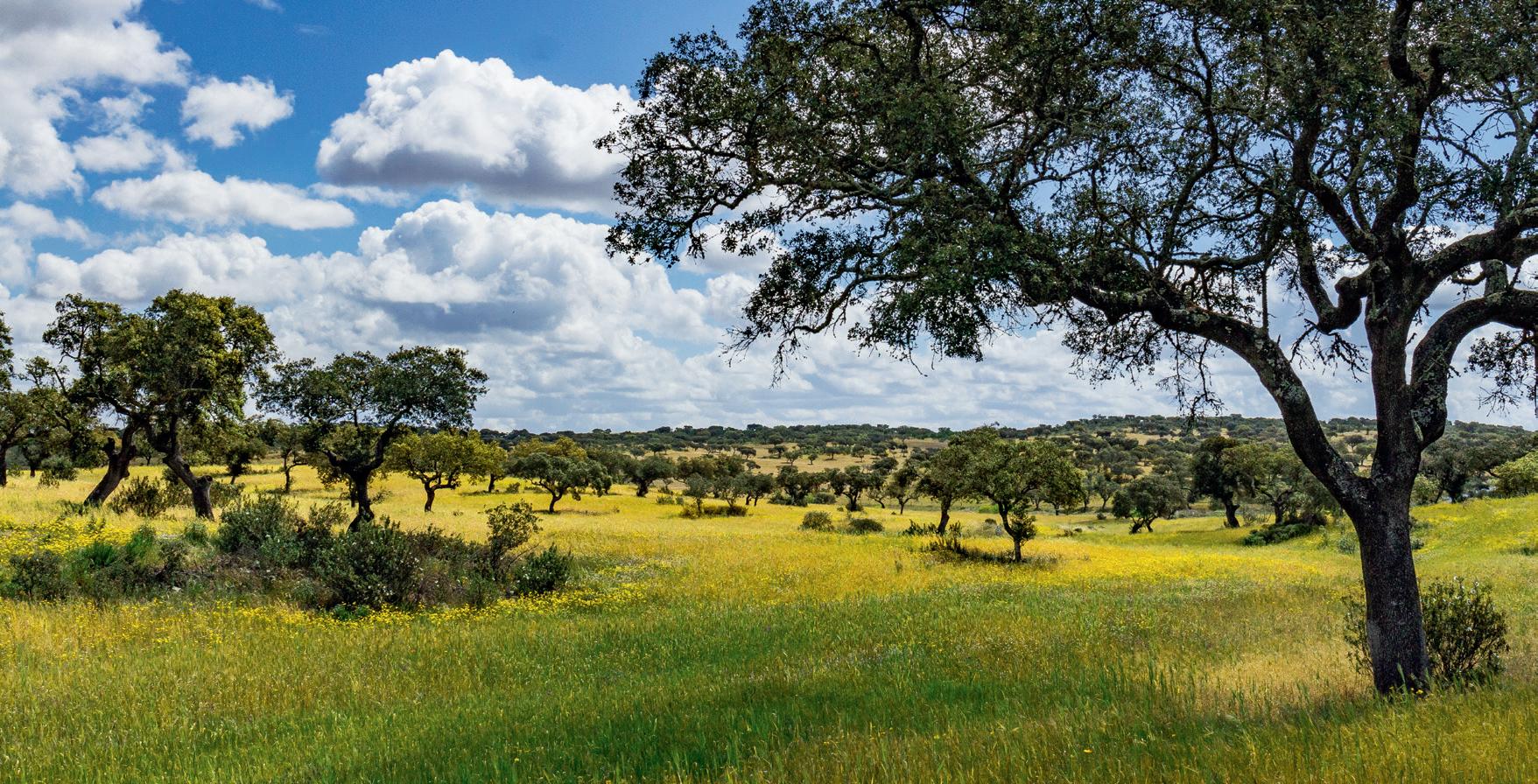
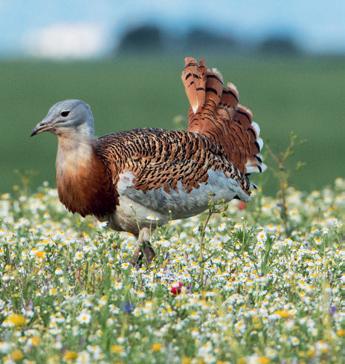
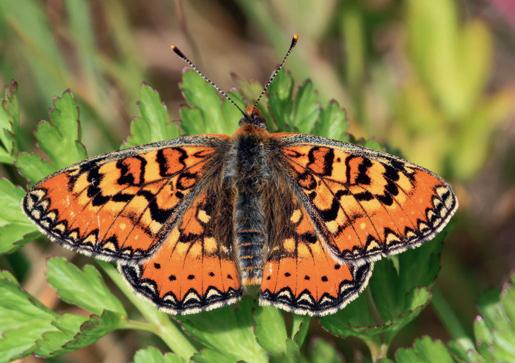
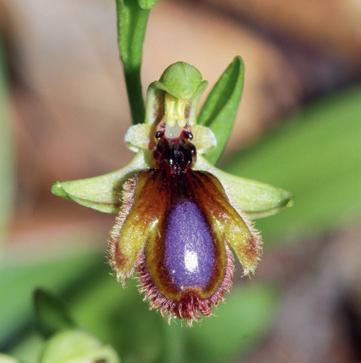
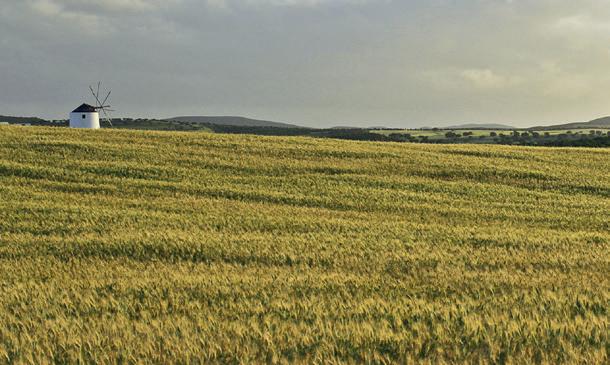

CROSSBILL GUIDES
Southern Portugal
From Lisbon to the Algarve
Crossbill Guides: Southern Portugal – From Lisbon to the Algarve
First print: 2018
Second print: 2024
Initiative, text and research: Dirk Hilbers, Kees Woutersen
Editing: John Cantelo, Brian Clews, Cees Hilbers, Riet Hilbers, Kim Lotterman, Gino Smeulders, Albert Vliegenthart
Illustrations: Horst Wolter
Maps: Constant Swinkels
Type and image setting: Oscar Lourens
Print: ORO grafic projectmanagement / PNB Letland
ISBN 978-94-91648-30-4
This book is made with FSC-certified paper. The printing process is CO2-neutral through carbon-offsetting. To compensate for the CO2-emissions of the printing processes, we’ve invested in a reafforestation project plus nature conservation in Europe. For more information, scan the qr-code. You can find the certificate of the carbon-offset on our website under ‘downloads’ on the Southern Portugal guidebook page.
© 2024 Crossbill Guides Foundation, Arnhem, The Netherlands
All rights reserved. No part of this book may be reproduced in any form by print, photocopy, microfilm or any other means without the written permission of the Crossbill Guides Foundation.
The Crossbill Guides Foundation and its authors have done their utmost to provide accurate and current information and describe only routes, trails and tracks that are safe to explore. However, things do change and readers are strongly urged to check locally for current conditions and for any changes in circumstances. Neither the Crossbill Guides Foundation nor its authors or publishers can accept responsibillity for any loss, injury or inconveniences sustained by readers as a result of the information provided in this guide.

Published by Crossbill Guides in association with KNNV Publishing. www.crossbillguides.org www.knnvpublishing.nl www.saxifraga.nl A
CROSSBILL GUIDES FOUNDATION
This guidebook is a product of the non-profit foundation Crossbill Guides. By publishing these books we want to introduce more people to the joys of Europe’s beautiful natural heritage and to increase the understanding of the ecological values that underlie conservation efforts. Most of this heritage is protected for ecological reasons and we want to provide insight into these reasons to the public at large. By doing so we hope that more people support the ideas behind nature conservation. For more information about us and our guides you can visit our website at:
WWW.CROSSBILLGUIDES.ORG
Highlights of Southern Portugal
1
Go birdwatching in the Alentejo, where steppe birds like bustards and sandgrouse share their home with the shrikes, Hoopoes, Bee-eaters and Azurewinged Magpies of the montado.

3
Explore the bays of Sado and Tejo, where thousands of shorebirds congregate and where you can combine field trips with sightseeing in historic Lisbon and Setúbal.
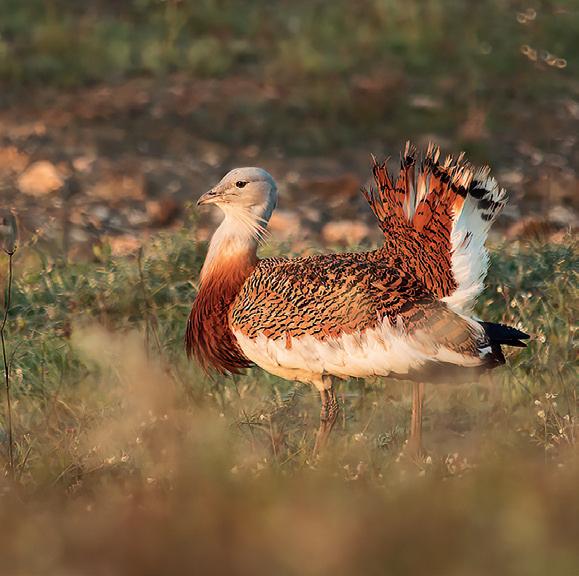
2 Go hiking along the shore of the Algarve with its beautiful, honeycoloured cliffs.

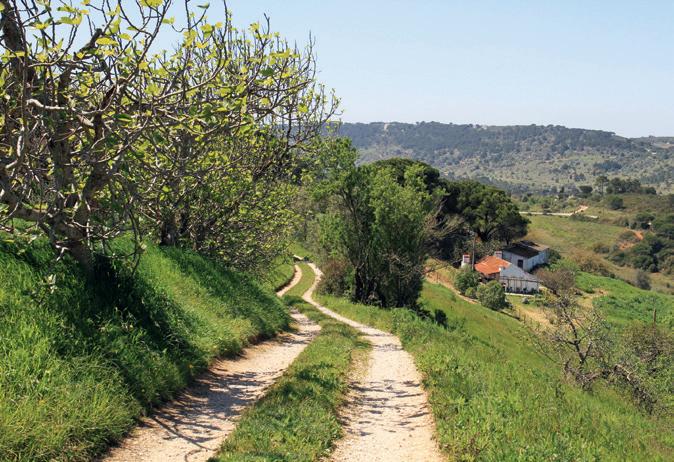
4 Go hiking in the lovely hills of the Serra da Arrábida or the Algarve, where orchids flower in profusion and butterflies are in abundance.
4 highlights of southern portugal
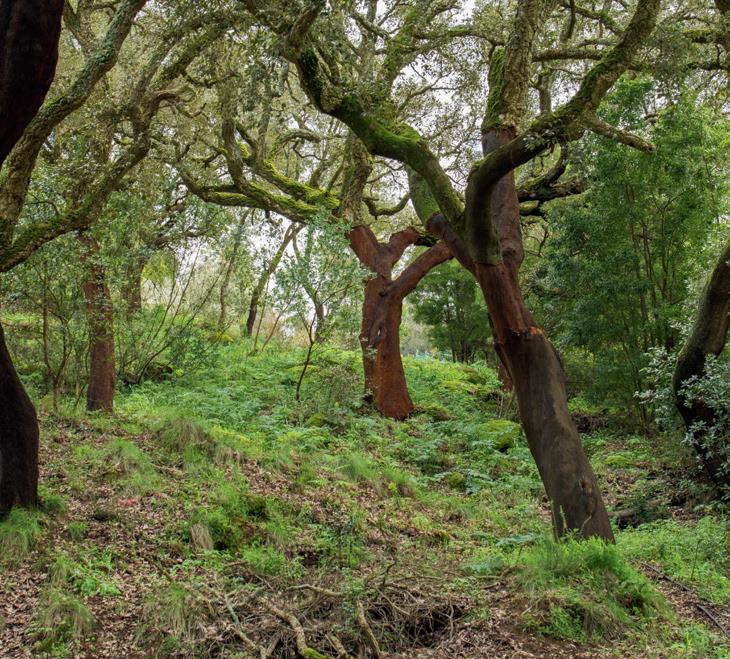
6 Enjoy Cabo São Vicente and the Costa Vicentina, where the dune and clifftop flora is rich in endemic wildflowers.
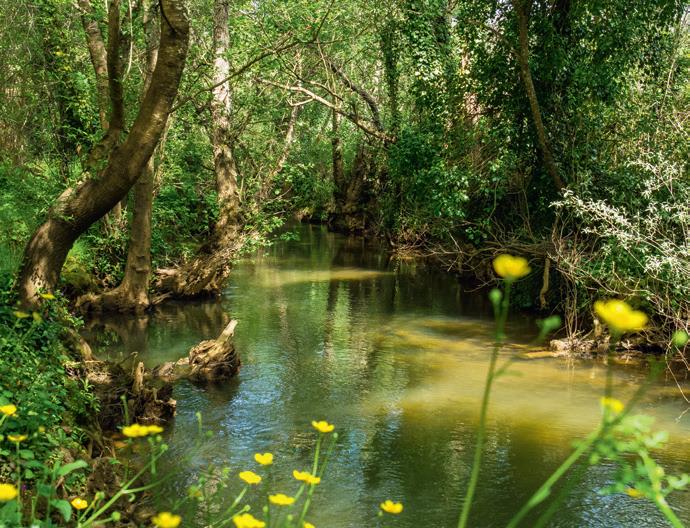
8 Visit the Cabos São Vicente and Espichel to watch seabirds like Gannets, terns, skuas, shearwaters, etc. passing offshore. Better still, get closer by adding a whale watching boat trip to your itinerary.
5 Climb the ‘balcony of the Algarve’, the Serra de Monchique, with its remnants of old cork oak forests.

7 Cruise along the hidden inland rivers – little known and little visited, but with a good number of rare dragonflies, butterflies and wildflowers.
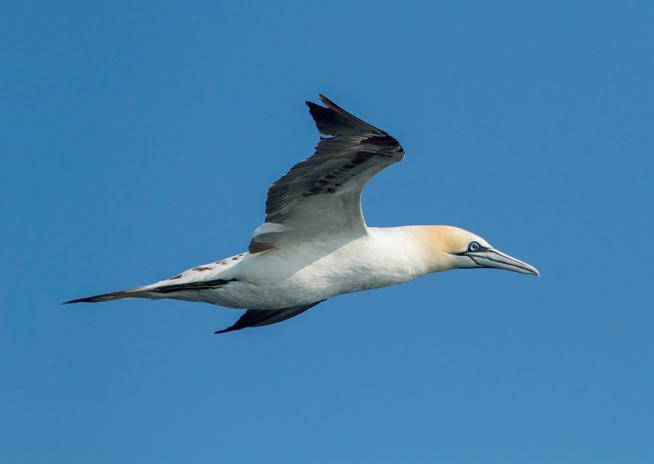
5 highlights of southern portugal
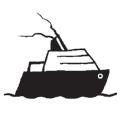





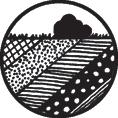
boat trip or ferry crossing
car route
bicycle route
beautiful scenery walking route
interesting history
interesting geology
about this guide
About this guide
This guide is meant for all those who enjoy being in and learning about nature, whether you already know all about it or not. It is set up a little differently from most guides. We focus on explaining the natural and ecological features of an area rather than merely describing the site. We choose this approach because the nature of an area is more interesting, enjoyable and valuable when seen in the context of its complex relationships. The interplay of different species with each other and with their environment is simply mind-blowing. The clever tricks and gimmicks that are put to use to beat life’s challenges are as fascinating as they are countless. Take our namesake the Crossbill: at first glance it’s just a big finch with an awkward bill. But there is more to the Crossbill than meets the eye. This bill is beautifully adapted for life in coniferous forests. It is used like a scissor to cut open pinecones and eat the seeds that are unobtainable for other birds. In the Scandinavian countries where pine and spruce take up the greater part of the forests, several Crossbill species have each managed to answer two of life’s most pressing questions: how to get food and how to avoid direct competition. By evolving crossed bills, each differing subtly, they have secured a monopoly of the seeds produced by cones of varying sizes. So complex is this relationship that scientists are still debating exactly how many different species of Crossbill actually exist. Now this should heighten the appreciation of what at first glance was merely a plumb red bird with a beak that doesn’t seem to fit properly. Once its interrelationships are seen, nature comes alive, wherever you are. To some, impressed by the “virtual” familiarity that television has granted to the wilderness of the Amazon, the vastness of the Serengeti or the sublimity of Yellowstone, European nature may seem a puny surrogate, good merely for the casual stroll. In short, the argument seems to be that if you haven’t seen some impressive predator, be it a Jaguar, Lion or Grizzly Bear, then you haven’t seen the “real thing”. Nonsense, of course.
But where to go? And how? What is there to see? That is where this guide comes in. We describe the how, the why, the when, the where and the how come of Europe’s most beautiful areas. In clear and accessible language, we explain the nature of southern Portugal and refer extensively to routes where the area’s features can be observed best. We try to make southern Portugal come alive. We hope that we succeed.
6
how to use this guide
How to use this guide
This guidebook contains a descriptive and a practical section. The descriptive part comes first and gives you insight into the most striking and interesting natural features of the area. It provides an understanding of what you will see when you go out exploring. The descriptive part consists of a landscape section (marked with a red bar), describing the habitats, the history and the landscape in general, and of a flora and fauna section (marked with a green bar), which discusses the plants and animals that occur in the region.
The second part offers the practical information (marked with a purple bar). A series of routes (walks) is carefully selected to give you a good flavour of all the habitats, flora and fauna that southern Portugal has to offer. At the start of each route description, a number of icons give a quick overview of the characteristics of each route. These icons are explained in the margin of this page. The final part of the book (marked with blue squares) provides some basic tourist information and some tips on finding plants, birds and other animals.
There is no need to read the book from cover to cover. Instead, each small chapter stands on its own and refers to the routes most suitable for viewing the particular features described in it. Conversely, descriptions of each route refer to the chapters that explain more in depth the most typical features that can be seen along the way.
We have tried to keep the number of technical terms to a minimum. If using one is unavoidable, we explain it in the glossary at the end of the guide. There we have also included a list of all the mentioned plant and animal species, with their scientific names and translations into German and Dutch. Some species names have an asterix (*) following them. This indicates that there is no official English name for this species and that we have taken the liberty of coining one. For the sake of readability we have decided to translate the scientific name, or, when this made no sense, we gave a name that best describes the species’ appearance or distribution. Please note that we do not want to claim these as the official names. We merely want to make the text easier to follow for those not familiar with scientific names. When a new vernacular name was invented, we’ve also added the scientific name.
An overview of the area described in this book is given on the map on page 12. For your convenience we have also turned the inner side of the back flap into a map of the area indicating all the described routes. Descriptions in the explanatory text refer to these routes.





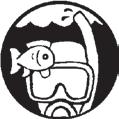


visualising the ecological contexts described in this guide interesting flora interesting invertebrate life interesting reptile and amphibian life interesting mammals interesting birdlife site for snorkelling interesting for whales and dolphins
7
8 Table of contents Landscape 11 Geographical overview 12 Geology 14 Climate 19 Habitats 20 Estuaries, saltmarsh and saltpans 22 Capes, dunes and beaches 29 Freshwater marshes and riverine habitat 33 Woodlands, montados, orchards and matos 38 Steppes and cereal fields 43 History 45 Nature conservation 52 Flora and Fauna 59 Flora 62 Mammals 74 Birds 79 Reptiles and amphibians 92 Insects and other invertebrates 99 Practical Part 107 Routes in the Lisbon – Setúbal area 108 Route 1: The Tagus Estuary near Alcochete 109 Route 2: The Tagus Estuary near Barroca d´Alva and Pancas 113 Route 3: The northern Sado estuary and Palmela 117 Route 4: Serra da Arrábida and Cabo Espichel 122 Route 5: A Walk in the Serra da Arrábida 126 Route 6: Sado Estuary and Tróia Peninsula 128 Route 7: Lagoa de Santo André 132 Additional sites Setúbal 135 Routes in the the Alentejo 141 Route 8: The Moura area 142 Route 9: From Sobral da Adiça to Barrancos 145 Route 10: Castro Verde plains 150 Route 11: Pulo do Lobo 154 Additional sites in Baixo Alentejo 158 Routes in the Algarve 163 Route 12: The Guadiana river near Alcoutim 164
of contents
table
9 Route 13: Castro Marim salt marshes 168 Route 14: Ria Formosa East 172 Route 15: Ria Formosa West 176 Route 16: Fonte de Benémola 180 Route 17: Rocha da Pena 182 Route 18: Odelouca valley and Serra de Monchique 184 Route 19: The Arade estuary 189 Route 20: The Alvor estuary 192 Additional sites in the Algarve 195 Costa Vicentina – the southwest coast 199 Route 21: Cabo São Vicente and the Sagres Peninsula 200 Route 22: Aljezur – river and dunes 206 Route 23: Along the Ceixe river 209 Additional sites in the Costa Vicentina 212 Tourist information and observation tips 217 Acknowledgements 239 Picture and illustration credits 240 Species list and translation 241 List of Text boxes Tidal differences 25 Waves on the ocean 32 Cork Oaks in Portugal 42 The Portuguese red list of endangered species 53 Natura 2000 57 Rice paddy birds: Glossy Ibis and Black-tailed Godwit 83 Visitors from Africa 85 The Iberian Azure-winged Magpie 87 Bird migration at the Sagres Peninsula 91 Clam fishing 112 Birds of the Castro Verde plains 151 Ecotourism code of conduct 222 table of contents
GEOGRAPHICAL OVERVIEW
There are few places in Europe where it is this easy to combine a city trip, the beach and fine hiking and birdwatching in a small area.
The Baixo Alentejo
Enter the Baixo Alentejo from the west coast and you will encounter rolling fields with wide views. Most of it consists of extensive areas of lightly wooded pastures and cereal fields. With only 152.000 inhabitants, this huge area is thinly populated. With its endless Holm and Cork Oak montado woodlands and cistus scrubs, the Alentejo has a special atmosphere. A key landscape feature is the broad Guadiana river which flows in from the east, then abruptly turns south, forming much of the border with Spain before reaching the Atlantic. There are vast steppe-like plains near Castro Verde and cereal fields around Beja.
The Algarve
The pretty, sandstone cliffs and beautiful beaches are what come to mind when one thinks of the Algarve. But the region has a lot more. Between the tourist towns and golf courses, there is plenty to see. The great attraction is the mixture of marshes and the many tidal lagoons, combined with the quiet, rural hinterland with its lovely limestone and granite hills and mountains a bit further inland. The region has a scenically spectacular coastline which is superb for birdwatchers, while the flora inland is, at least in early spring, not to be missed!
Costa Vicentina and Serra da Arrábida – the southwest coast
The southwest coast is different from the rest. The Costa Vicentina is a narrow strip along a coast with impressive sea cliffs, which culminate at its southwestern point, the famous Cape St. Vincent. This is one of the most important areas of Portugal from a botanical perspective. Costa Vicentina’s wall of cliffs is interrupted by small beaches and dunes at the estuaries of a series of rivers that originate from the nearby Serra de Monchique.
Together with these cliffs, the river valleys and estuaries are Costa Vicentina’s finest characteristics. From the coast it is only 20 km to the Serra de Monchique which, at 902 metres, is the balcony of the Algarve. The unique climate supports a special ecosystem with an attractive flora and fauna.
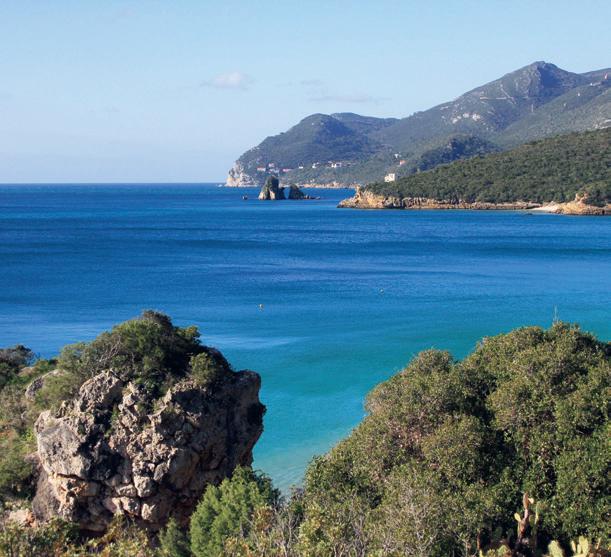
13 LANDSCAPE
The limestone cliffs of Serra da Arrábida.
Habitats
What are the ingredients of the perfect wildlife holiday? Whilst this will differ from person to person, beautiful landscapes and a rich flora and fauna are likely to be key ingredients. And in order to get that, an area with a high diversity of intact, outstanding habitats is what you need. And it is what you get in southern Portugal.
Typical of this region is the combination of extensive areas of superb intact steppes and woodlands in the interior, and a swift succession of many small natural areas at the coast that are radically different from one another.
In the following chapters, we describe each of the major habitats of southern Portugal. The steppes are discussed on page 43 and the open oak woodlands (called montados) and the scrublands (or matos) on page 38. Both these extensive ecosystems are complemented by intact and,
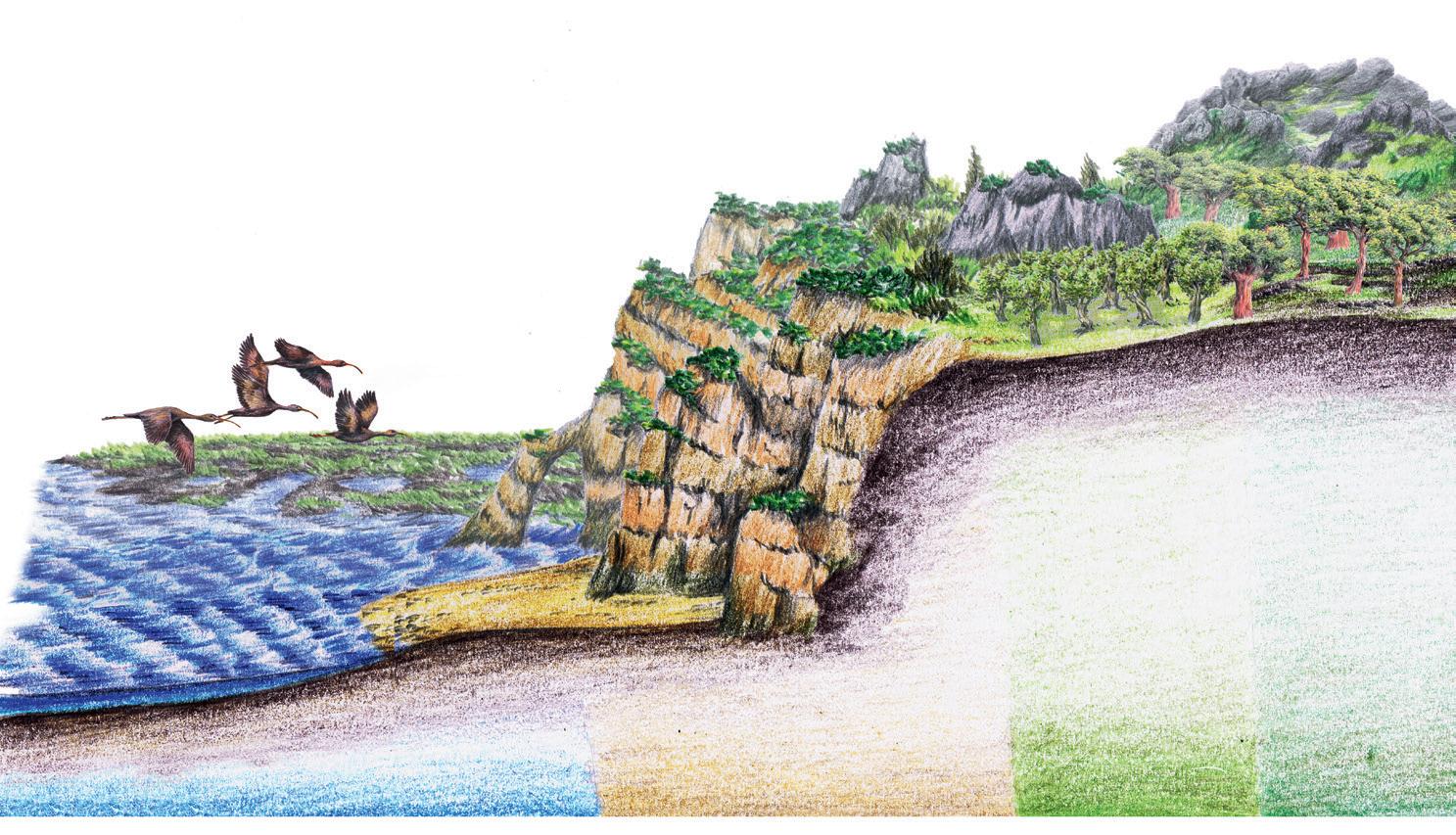
20 CROSSBILL GUIDES • SOUTHERN PORTUGAL
Seaandcoastalmarshes(p.22)
Limestonehills(p.41)
Volcanicoutcrop(Monchique)
Cliffcoast(p.29)
HABITATS
HABITATS
for the most part seasonal river valleys which are the subject of the chapter on page 33.
Closer to the south coast, the landscape changes subtly – the montados make way for orchards, the matos change in species composition – a sure sign you’ve arrived at the limestone coastal zone.
The actual coastline is radically different. There are estuaries, saltmarshes and salt pans near Lisbon, Setúbal and in various places on the Algarve’s southern coast, which are discussed on page 22. A very different ecosystem is that of the coastal headlands and dunes, which are often situated close to the salt marshes and make the south Portuguese coast so diverse. These are described on page 29. The final habitat discussed in detail covers only a very small area in the region, yet one that is of vital importance both for nature and for people: freshwater marshes. They are found both at the coast and inland, and are described on page 33.

Montados(p.38)
Steppes(p.43)
Montados(p.38)
Riverinehabitat(p.36)
Montados(p.38)
21 LANDSCAPE
Cross-section through the habitats of southern Portugal.
Woodlands, montados, orchards and matos
Beautiful montados are a prominent feature on routes 2, 3, 8, 9, 10, 11, 12, 18 and 20, plus site F on page 139, and sites A to E on pages 158 to 160. Pinewoods are present on routes 5, 6, 7, 21 and sites E on page 214. Riparian forest features on routes 12, 18, 22 and 23. Scrublands are found all over, but the unique habitat of the coastal matos is present on routes 4, 21 and 22, plus sites A, B, D, E and H on pages 212 to 214.
There is a revealing map on Portuguese woodlands in a book on Mediterranean landscapes (The Nature of Mediterranean Europe; by Grove and Rackham): whereas on the Spanish side of the border, only 3% of the area is wooded, on the Portuguese side, no less than 97% is treecovered. Yet if you travel in the area, you’d have a hard time figuring out on which side of the border you are. The landscape is exactly the same. This goes to show how difficult it is to classify the landscape that the Portuguese call montado and the Spanish refer to as dehesa. The montado (we’ll stick to the Portuguese name here) is perhaps best described as lightly wooded pastureland. It is a huge expanse of Cork and Holm Oaks, usually well-spaced, with a mixture of grassland, scrub and even, occasionally, cereal fields. Some montados are dense enough to resemble true forests, while others can be so open that they are more reminiscent of savannahs. Another great difference between the montado and the forests that we know from temperate Europe is the way they are exploited. In the montado, forestry plays a secondary role. All trees are carefully pollarded to produce wide tree crowns, which shield the soil from sun and rain and produces lots of acorns. The pastures beneath the trees are exploited by sheep, cattle and pigs. Low-intensity husbandry is the main function of the montado, then comes the production of cork, timber (and in bygone days charcoal), cereals and honey. In short, the bounty of the montado is very diverse and its landscape is unique – you can find it only in southwestern Iberia.
The montados are the dominant landscape in much of the Alentejo. It is a wonderful and ecologically very rich area. If you pass through the landscape, you’ll find birds everywhere. Hoopoes, Bee-eaters, Iberian Grey and Woodchat Shrikes, Thekla’s and Woodlarks, Azure-winged Magpies, Little Owls and lots of Mediterranean songbirds – the diversity is great. It is interesting to see how the montado birdlife gradually changes between different sites. Short-toed Treecreeper, Chaffinch, Great Tit and Nuthatch
38 CROSSBILL GUIDES • SOUTHERN PORTUGAL
MONTADOS, ORCHARDS AND MATOS
WOODLANDS,
WOODLANDS, MONTADOS, ORCHARDS AND MATOS
become increasingly common in denser stands with older trees. A little further on, where the trees are much wider spaced, you may find Stone Curlew. In rocky terrain near rivers, there are Black-eared Wheatear, Blue Rock Thrush, Rock Bunting and Rock Sparrow. Apparently, the montado ecosystem is right at the crossroads of different habitats and offers home to species from all of them. This holds true not just for birds – the reptile, amphibian and mammal world is rich as well. Nearly all species of snake or lizard that occur in southern Portugal are found in the montado. Among the mammals, the Genet and Egyptian Mongoose are particularly frequent. Only the diversity of wildflowers and butterflies lag a little behind – a result of the poor and uniform soils.
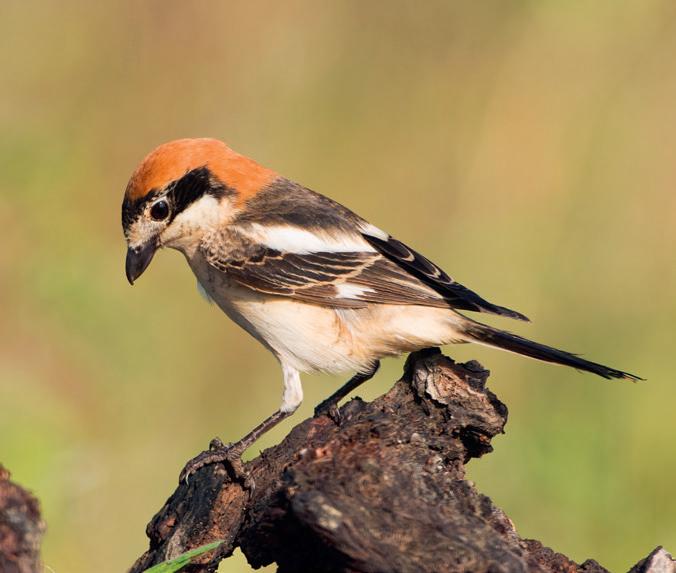
Extensive Holm and Cork Oak groves (montados) cover much of the surface of the Alentejo (bottom). These savannah-like landscapes have a superb birdlife. One of the common birds is the Woodchat Shrike (top).
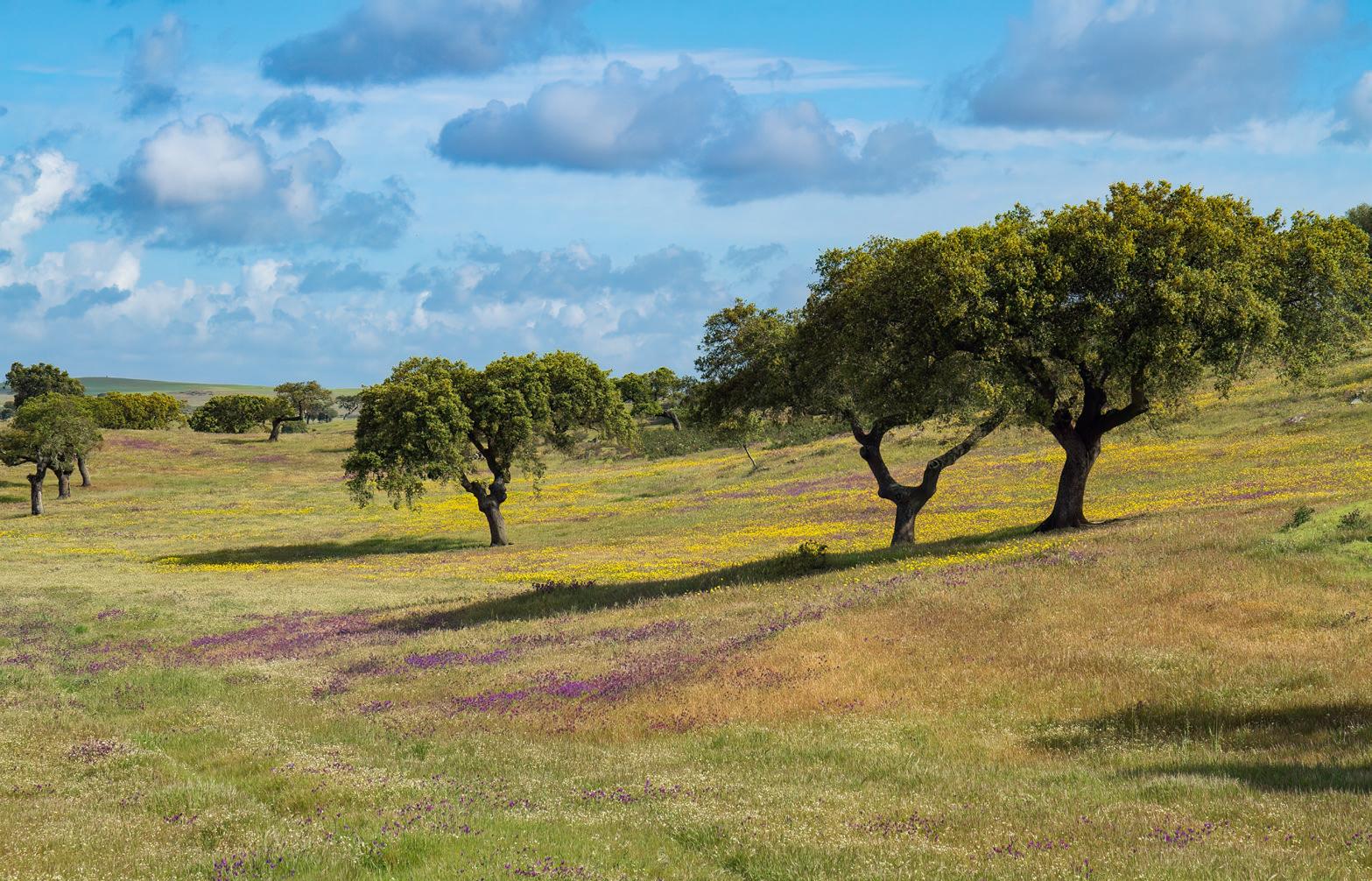
39 LANDSCAPE
WOODLANDS, MONTADOS, ORCHARDS AND MATOS
The montado is not the only kind of woodland. On sandy soils on the west coast are some large areas with Umbrella Pine forests. This forest is open as well, but there is no animal husbandry here. The trees play an important role in fixing the sand, as well as providing timber. Along some of the rivers, most notably in the south and southwest, there are fine riparian woodlands. A narrow emerald ribbon of Alder and Ash trees follows the course of the streams down to the coast (see page 36). On the Costa Vicentina and Serra de Monchique, there are vast areas of Eucalyptus, planted for the paper pulp industry. Whereas the Spanish have abandoned the planting of Eucalyptus, because of the disastrous effects on the ecology, ground water and soil, the Portuguese unfortunately still continue the practice. The Eucalyptus plantations are nothing short of an ecological crime, leaving entire hillsides dead and deserted (see page 55).
Matos
Scrublands in Portuguese are called matos. In most places, different species of cistus dominate the scrub. Especially after a wildfire or after a clearcut, the scrubland that returns may appear rather uniform. Especially in the Alentejo and northern half of the Algarve where the soils are poor and acidic, the scrublands are ruled over by a single species: the Gum
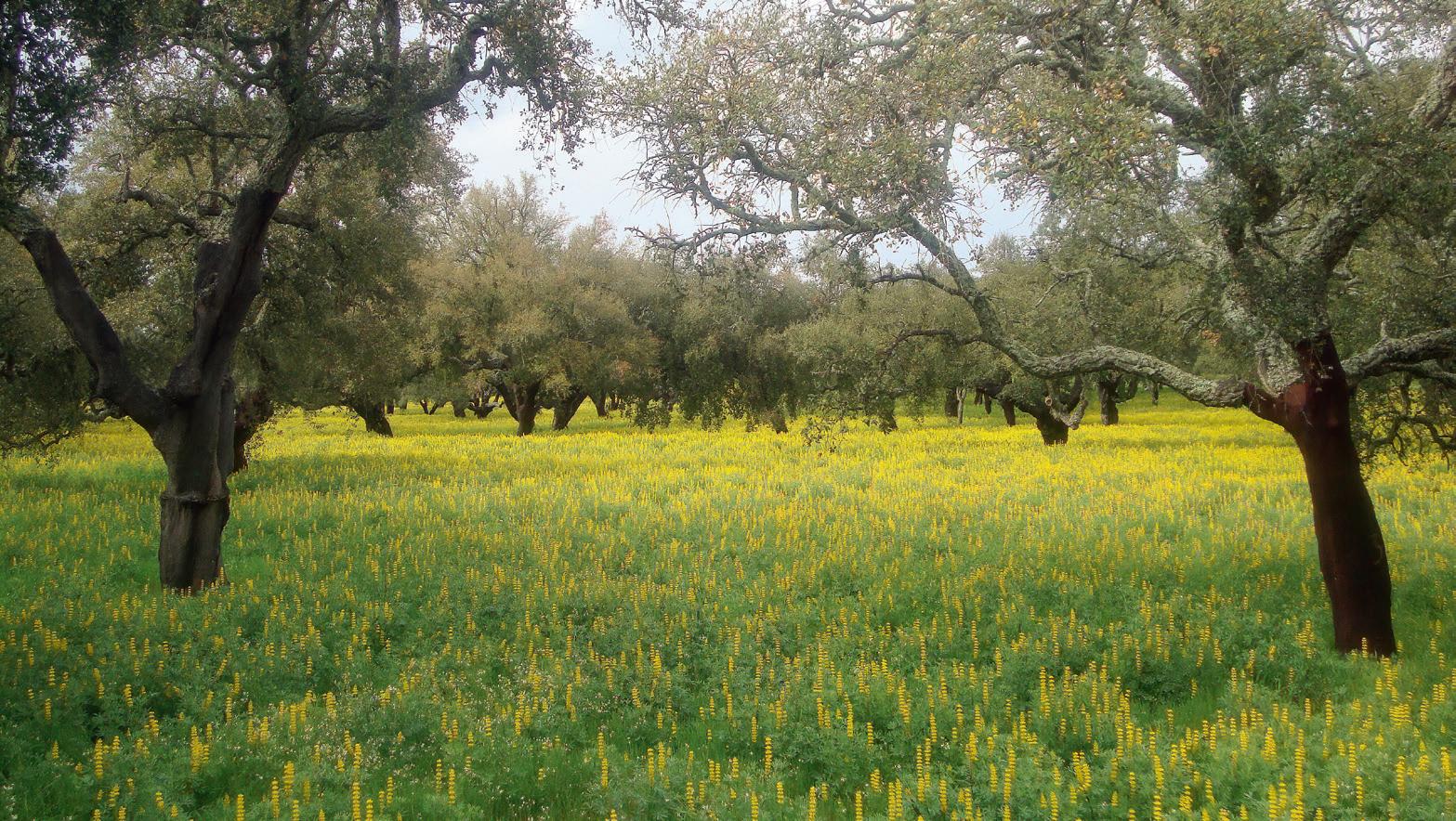
40 CROSSBILL GUIDES • SOUTHERN PORTUGAL
Cork Oak montado with Yellow Lupin on the shores of the Tejo Bay (route 2).
WOODLANDS, MONTADOS, ORCHARDS AND MATOS
Cistus. It is a beautiful plant, though, with large white, delicate petals, each with a typical, dark red dot (present on about 90% of the plants). The top of the plant is sticky and exudes a wonderful, herbal scent. So, there is much to say in favour of the Gum Cistus, except that doesn’t allow much other vegetation. All bushes are about the same height and density, so a walk through those matos is a rather dull undertaking. Only the rasping call and short sweet warble of the Sardinian Warbler will be a frequent companion.
The Gum Cistus provides a good litmus test (almost literally) for the acidity of the soil. It grows only on acidic soils and disappears where limestone or other, more basic soil types occur. Here, the Grey-leaved Cistus (with pink flowers), Rosemary, Thyme and other species occur, each with its own height, structure and ecology. These scrublands are much richer and boast a wider variety of insects, reptiles and birds. Closer to the coast, the wind and drought makes tree growth impossible. This is where you’ll find the most special matos, with those on Cape St. Vincent the true champs. The low, windbeaten coastal scrub has an enormous diversity in wildflowers, which we describe in further detail on page 63 and route 21. In the dry, Mediterranean landscape of southern Portugal, scrublands appear both as the natural ‘climax’ vegetation and as a sign of disturbance in places where naturally, a woodland would grow. The natural sites for scrublands are rocky, exposed slopes and cliff-tops, the places where wind, shallow soils and drought doesn’t allow trees to develop. The scrubland that grows here is quite diverse, also on acidic soils – patches of dense bushes alternate with grassy parts, some rocky
Flowery scrubland (matos) with Gum Cistus and Purple Viper’s-bugloss –possibly the two most common wildflowers of the Alentejo.
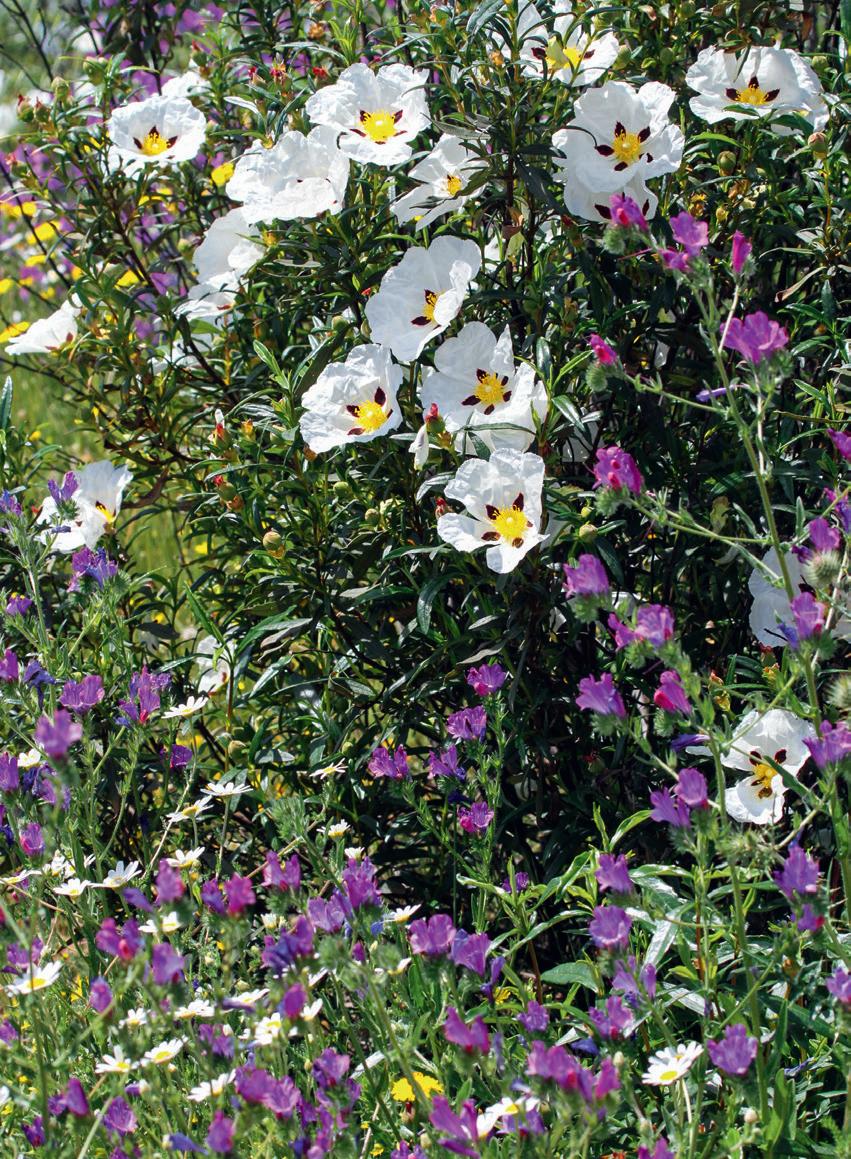
41 LANDSCAPE
The world’s largest Cork Oak forests are found in southern Portugal.
outcrops. Here and there, a tree found a crack in the rock through which the root can reach water.
On better soils, Mediterranean woodland of Holm and Cork Oaks will eventually take over from the shrubs, but even here, the development to forest is a slow process. The cistus scrub that takes over after a forest fire or other kind of disturbance may persist for years before the trees can return.
Cork Oaks in Portugal
Cork is the bark of the Cork Oak (Quercus suber ), native to the countries of the western Mediterranean. The cork bark protects the trunk and branches against wildfire. Where other trees and plants after a fire recover by growing new individuals from seeds, the Cork Oak renews its bark, makes new shoots and resurrects as an arboreal Phoenix.
Cork as a material is impermeable and elastic and used as a stopper in wine bottles and for other products. Harvesting the cork without damaging the tree is a tough work that requires a lot of skill. A small axe and specialised tools are used by a team of harvesters that work together on a single tree. The skin of a recently harvested tree first has a pale, sandy colour, but soon develops an impressive, velvety red that disappears gradually as the years go by and a new bark grows.

The cork is separated from the tree for the first time when it is 25-30 years old. After about nine years the tree can again been harvested. On old trees you may see the result of several treatments on one and the same tree. Whereas other trees await a certain death when their bark is removed, the Cork oak survives, although the treatment remains an assault to its health. The lifespan of a Cork Oak is up to about 250 years, but harvesting the bark shortens it by about a 20%.
Portugal accounts for half of the world production of cork. Cork trees are protected and may never be cut without special permission, even if they are old. Local people depend on Cork Oak forest as a part of their economy and therefore look after them well.
42 CROSSBILL GUIDES • SOUTHERN PORTUGAL
MONTADOS, ORCHARDS AND MATOS
WOODLANDS,
Steppes and cereal fields
Steppe habitat is found on routes 8, 11 and above all around Castro Verde, route 10. Sites F and G (pages 161-162) are also steppe sites.
Portugal’s largest and most important regions of cereal steppes and steppe grasslands are found around the town of Castro Verde. As early as Roman times, this region was important for both cattle grazing and cereal production.
The steppes of Portugal are not naturally treeless (Some authors therefore insist on calling them pseudo-steppes), but are the result of a rotation of growing cereals followed by several years of fallow land, in which the land is grazed by sheep. The result is a locally changing but overall stable mosaic of cereal fields, fallow land, fields and more or less natural grasslands full of annual and biannual flowers. Especially Purple Viper’s-bugloss can flower en masse and put up spectacular shows in spring. On these poor soils, there are many rocky areas that function as safe havens for reptiles and rodents as well as for wildflowers that escape the plough and the teeth of grazing sheep. Small streams and ponds add the finishing touch to this diverse ecosystem.
The vast steppes around Castro Verde are a riot of colour in spring, when swathes of annuals are in full bloom, such as these Purple Viper’s-buglosses.
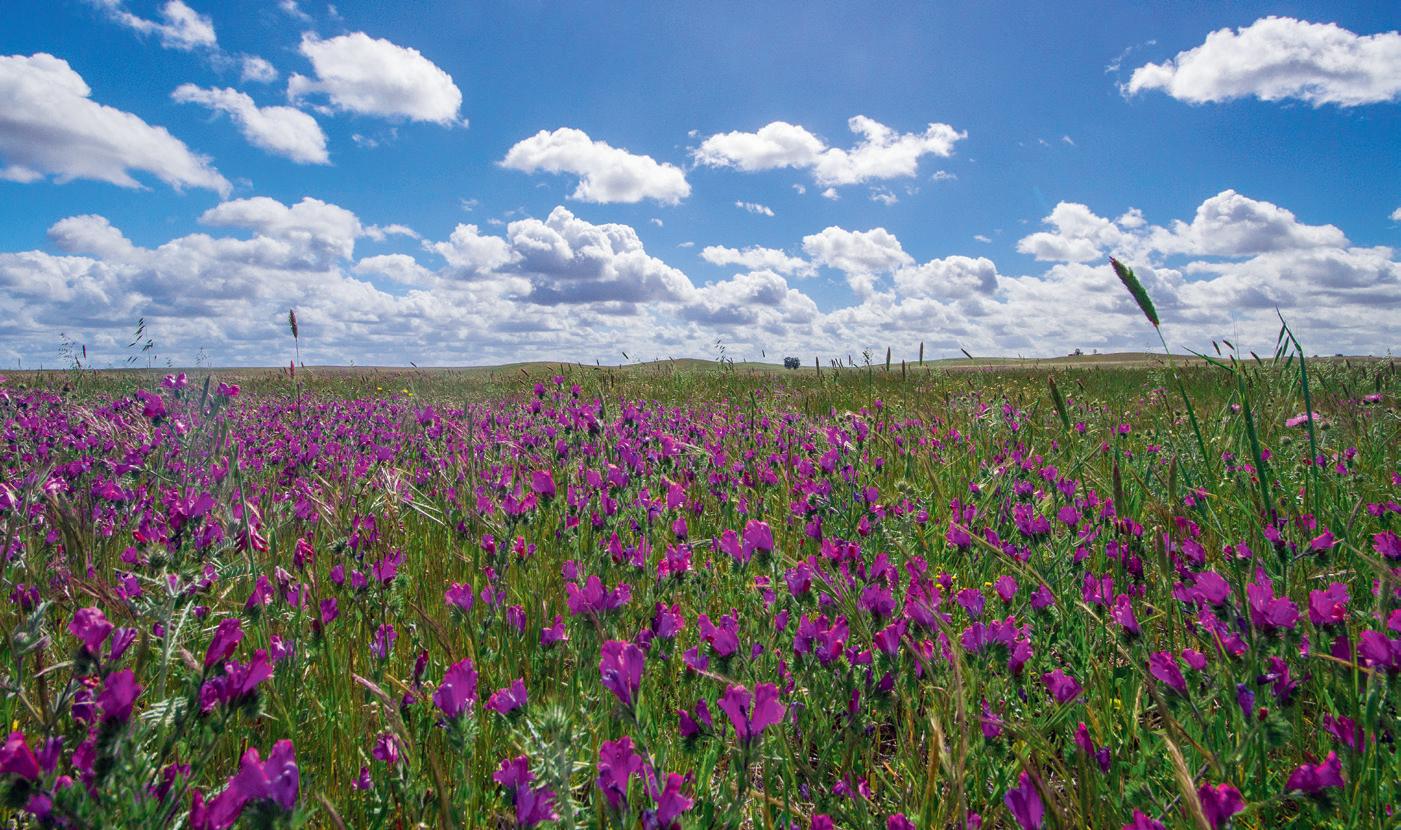
43 LANDSCAPE STEPPES AND CEREAL FIELDS
Apart from the spectacular empty landscape, birds are the biggest attraction of the steppes. A visit to southern Portugal simply isn’t complete without a visit to the steppes of Castro Verde. Large numbers of both Great and Little Bustard plus Black-bellied Sandgrouse, Lesser Kestrel, Black-winged Kite, Montagu’s Harrier, Great Spotted Cuckoo, Stone
Curlew and Roller form the main attractions. There are many more great birds too including, in recent years, Spanish Imperial Eagle.
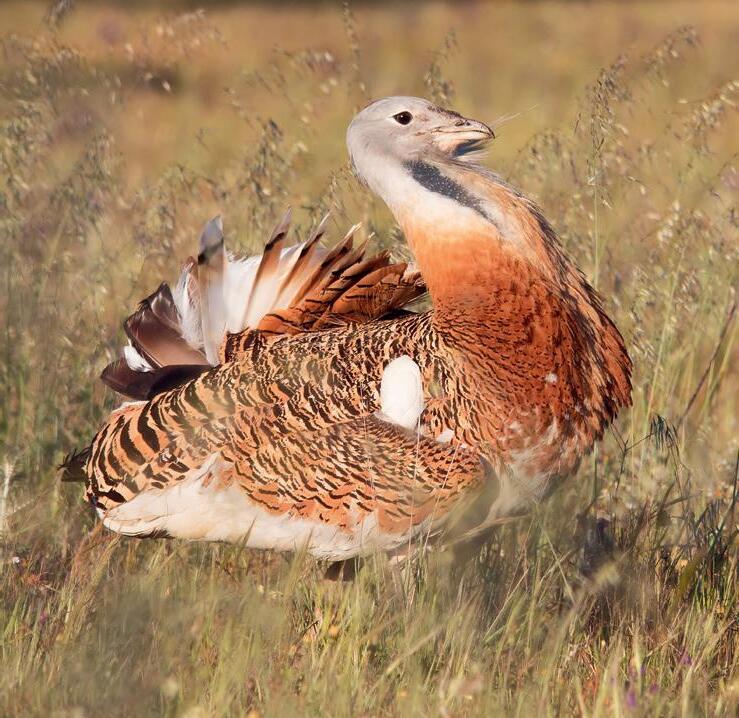
The Great Bustard (top) is one of the delights of the steppes of the Alentejo. It profits from the mixture of herb-rich, grassy fields and areas with cereal steppes (bottom) that together are rich in grains and insects.
Key to this wealth of birds are the large numbers of insects (mainly grasshoppers) and rodents, Iberian hares and rabbits that inhabit these steppes. They in turn are drawn to the many seeds and herbs of the grasslands. Apart from the Castro Verde plains, there are several other areas of cereal steppes, in particular around Beja. These are rather different though. The soils are much more fertile and the cereal fields are larger, more uniform and more intensely farmed. Here too are important populations of steppe birds, but not in the densities found around Castro Verde.

44 CROSSBILL GUIDES • SOUTHERN PORTUGAL
STEPPES AND CEREAL FIELDS
History
Early history
Human habitation in what we now refer to as Portugal dates back to about 30,000 years ago, but we know little about the country’s early history. Farming, with its inevitable impact on the ecology of the area, arrived around 5,000 BC. The introduction of bronze (an alloy of copper and tin) around 2,000 BC stimulated agriculture, the exploitation of Portugal’s tin resources and th e development of trade routes to Britain. Around 800 BC, the Phoenicians, partly attracted by these mineral resources, started to trade with the inhabitants of the Iberian Peninsula and established the first settlements on the Portuguese south coast where they mixed with Iberians. A little later, Greek traders arrived and introduced coinage, olive cultivation and writing. Celtic tribes entered Portugal from the north about 700 BC, but they did not become established in the south. However, the new iron technology they brought with them would have allowed a greater exploitation of natural resources throughout the region.
The Romans and the Moors
When the Romans invaded the Iberian Peninsula in 210 BC, the conquest of southern Portugal was easy. The Romans ruled and organized most of the country for more than five centuries. Most of Portugal became part of the province south of the river Duero, Lusitania (including the Spanish Extremadura and western Andalucia). The Roman language, its customs and culture were fully adopted in the Iberian provinces. Trade increased, roads and cities were built. Roman ruins can still be found in the Algarve, e.g. near Vilamoura (Algarve; see site B on page 196) and on the Guadiana river near Alcoutim (route 12).
With the fall of the Roman Empire in the beginning of the 5th century, people of German origin invaded the Iberian Peninsula. The Visigoths, who became the dominant group, adopted the Christian religion and mixed with local people but their rule was plagued by internal divisions. The arrival of the Moors on the Peninsula from North Africa in 711 resulted in a rapid conquest of southern Portugal, leading to greater stability and thus many centuries of prosperity. Agriculture became more important thanks to greater productivity and new crops such as citrus and rice. The Moors made Silves the capital of the Algarve (from the Arabic al-Gharb meaning ‘the west’). Silves became more important than Lisbon, the old Roman capital. Another important town was Mértola in the Alentejo which the Moors ruled for more than 500 years. Mértola had
45 LANDSCAPE
HISTORY
The richest areas for wildflowers in southern Portugal:
1 Limestone hills of Serra Arrábida and Cabo Espichel, with lots of bulbs and orchids.
2 Dune flora of the west coast, with a specific set of coastal species, many of which are endemic.
3 Cape St. Vincent, which is species rich, with many rare and endemic species.
4 Monchique, which has a different flora from the surroundings due to high precipitation and acidic soils.
5 Barrocal, a limestone zone very rich in orchids.
FLORA
Flora
Rich cliff flora is found on routes 4, 21 and sites A and D on pages 212-213. The dune flora of southern Portugal is very special and can be enjoyed on routes 6, 7, 14, 15, 21, 22 and sites D on page 213 and E on page 214. The saltmarsh flora is easily observed on routes 6, 14, 15 and 20. The limestone flora is impressive on routes 3, 4, 5, 9, 16, 17 and sites A and B on page 212. A very attractive flora of granite hills can be enjoyed near Monchique, route 18.
Come in spring and the flora of southern Portugal is a vivid spectacle of colour. Brooms, rockroses, lavenders and thymes paint the landscape in all imaginable hues of purple, yellow, white and blue. There are stout and impressive plants like the bright blue Portuguese Squill (p. 68), the thick yellow spikes of the Cistanche (p. 22), the pink dots of the Nakedman Orchids (p. 123) and the large, paper-thin sheets of the Gum Cistus (p. 41). Other wildflowers are more subtle, graceful and delicate, such as the narcissi, orchids and toadflaxes in a dazzling variety. In the Alentejo the ground turns purple with Purple Viper’s-bugloss, is white-washed by daisies and chamomiles and subsequently carpeted with all sorts of yellow crucifers and composites.
The right time is rather short though and the peak comes early in the year. From late February to early May, southern Portugal is a riot of colour, but as soon as it gets hot and dry, the flowers disappear.
The short season is the result of the special climatic conditions of the far south: the winters are very mild and the summer heat and drought sets in early. This shifts the flowering season to earlier in the year. Since there are no cooler high mountains in the area and very little permanent water, there is no refuge from the summer heat for late bloomers – hence the concentration of the flowering period in early spring.

The spring flora is not only impressive in its profusion but also by the presence of some attractive species. Southern Portugal, more precisely the Algarve and south-west coast, is home to a fair number of highly localised or even endemic wildflowers.
The flora of the Algarve is well studied. Usually, it is divided into three different regions that coincide with the geological zone (page 14): the coast or
62 CROSSBILL GUIDES • SOUTHERN PORTUGAL
1 2 3 4 5
Littoral, a strip of limestone hills known as the Barrocal and the interior Serra with mostly acidic soils. The area described in this book is much larger but, with some modifications, these distinctions are useful in getting to grips with the flora.
Flora of the coast
The coastal region is the most diverse and attractive from a botanical perspective. There are dunes, salt marshes, cliffs and wind-beaten headlands, often in close proximity to one another. Each have a rich and attractive flora of their own. It is in this region that you’ll find a large number of endemic wildflowers – species that occur nowhere else than here on this coast. The pearl in the crown is the magnificent Cape St. Vincent, which even has a number of wildflowers unique to it alone, plus a large number of species that are typical of the Iberian southwest coast.
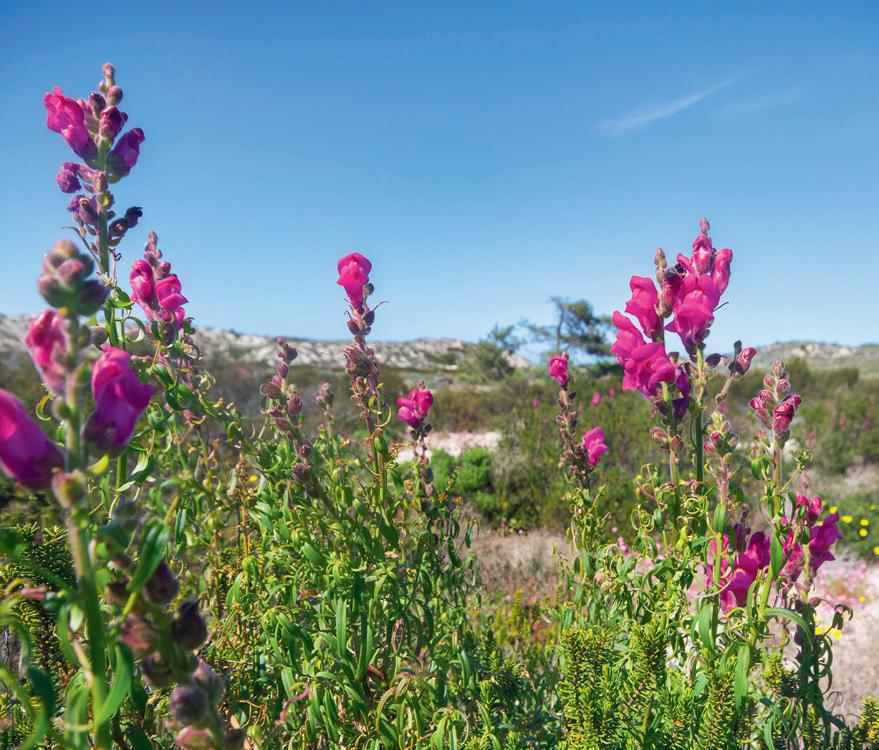
The matos in spring boast a very high number of flowering herbs and shrubs.
If you look at a flora of Portugal (the online flora www.flora-on.pt is excellent for this) you’ll find many wildflowers that occur on the coast roughly from Lisbon, round Cape St. Vincent, across the border into Spain and even on to Tarifa. Like the local micro-climate, this ecological region is called, in botanical jargon, Lusitanian – warm in summer, extremely mild in winter and strongly influenced by the ocean. The conditions for growth here are so different from the climatically harsh interior, that one could see this ecologically as an island, bordered by a ‘sea’ of different environmental conditions. On such ‘islands’, plants may evolve into new species and that is exactly what happened here. That’s why there are so many endemic species (see box).
Apart from Cape St. Vincent, the dunes and capes of the entire western coast are very rich in wildflowers, with the Cabo Espichel and Serra da Arrábida being further hotspots.
A wildflower walk around one of the capes (Cape St. Vincent or any other) typically means going back and forth between the most exposed headlands, where hardy species like Goldcoin, Saint Vincent Cistus*
FLORA AND FAUNA 63 FLORA
The coast of the Algarve, in particular the southwestern parts and the limestone hills just inland, are superb wildflower haunts. The rare Cadiz Daffodil* (Narcissus gaditanus) is one of the spring delights here.
FLORA
(Cistus palhinhae ; p. 60) and the invasive, South-African Hottentot Fig can be found, to several hundred metres inland, where the diversity of species is much higher. Here, sheltered between the shrubs, there are Spanish Fritillaries, Two-leaved Gennarias, Hoop-petticoat Daffodils, Snapdragons and Sawfly Orchids. A common shrub on Cape St. Vincent is the aforementioned Saint Vincent Cistus*, which has shiny, sticky leaves and large white flowers. It is closely related to the Gum Cistus which is widespread on acidic soils in the interior, but the Cape St. Vincent version is much lower and has more rounded (and glossier) leaves.
Endemic wildflowers of the south-west coast
Saint Vincent Bucklar-mustard* (Biscutella vicentina ), Rothmaler’s Catchfly* (Silene rothmaleri ), Astragalus tragacantha, Shrubby Violet (Viola arborescens), Saint Vincent Cistus* (Cistus palhinhae), Algarve Toadflax (Linaria algarviana ), Ficalho’s Toadflax (Linaria ficalhoana ), Saint Vincent Germander* (Teucrium vicentinum), Thymus camphoratus, Hackel’s Bellevalia (Bellevalia hackelii )
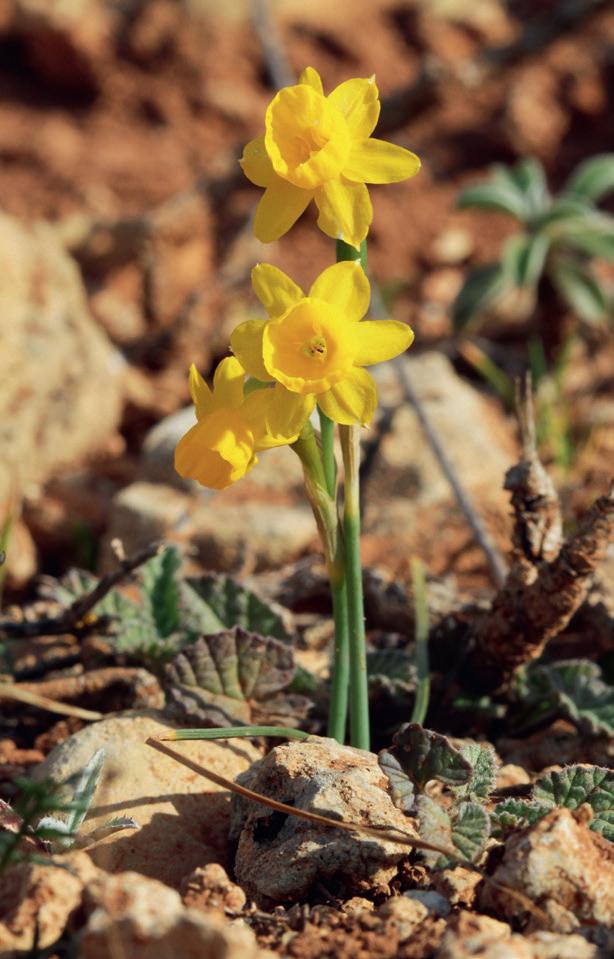
On many headlands, low dune complexes have formed, which have a very different set of wildflowers. Notable species here are Portuguese Crowberry, Spiny Thrift, Yellow Rockrose, Wrinkle-leaved Cistus and Creeping Gromwell* (Lithodora prostrata). Between these shrubs grows a wealth of wildflowers, many of which have only small, Lusitanian ranges. The environment of cliff slopes is one of extremes – intense solar radiation (on southfacing cliffs), drought exacerbated by strong gales, salt spray and unstable soils which make for a setting that is both severe and unique. It is here that some of the special wildflowers are found. One of them is the Shrubby violet, among the few European species of pansy to form a shrub and also extremely rare: it only grows at Cape St. Vincent and Cape Trafalgar in Andalucia. Other rarities include the sea-lavender Limonium virgatum and the Cape St. Vincent endemic pink Silene rothmaleri.
64 CROSSBILL GUIDES • SOUTHERN PORTUGAL
One group of wildflowers that occur on many headlands (as well as in the interior) are daffodils. The hundreds of thousands of Hoop-petticoat Daffodils on Cabo Espichel (no exaggeration!) are a positive assault on the retina. The cliffs of the Costa Vicentina also host a number of rare species. The daffodils are something special in Iberia anyway. The genus of Narcissi evolved on the Peninsula and it is here that the diversity of species is the highest. In fact, within the area of this book, no less than 8 species occur, and in Portugal as a whole there are 17 species, plus numerous subspecies.
Once you’ve trotted around for a little while grappling with the cliff flora, you’ll notice that one of the attractions of Portugal’s coastal flora is that dunes and salt marshes are usually close by. This adds a second string to your bow on a day out, since the dune flora is both distinct and particularly attractive.
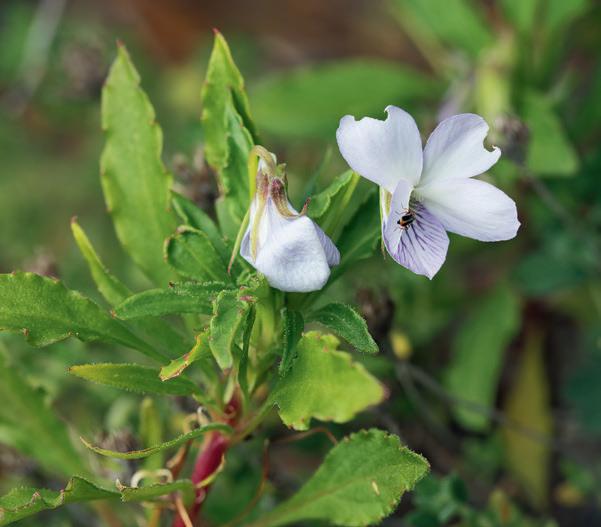
Below the dunes lies a subterranean reservoir of freshwater. It is there, but to reach it plants need to invest in deep roots. The perennial, deep-rooted species are Spiny Thrift, which forms tussocks with pink flowers, Dune Galingale, Coastal Crucianella, Cottonweed, the yellow Branched Restharrow* (Ononis ramosissima), Yellow Rockrose, Shrubby Figwort and the familiar Marram Grass.
Other dune plants follow a different strategy: germinating, flowering and setting seed in the short favourable season when it rains. The Stitchwort-leaved Allseeds* (Polycarpon alsinifolium), the white-flowering Nice Catchfly* (Silene nicaeensis), the pink, sticky Seaside Catchfly* (Silene littorea) and various toadflaxes are among these species. In the dunes you’ll see a similar change as on the headlands when you walk inland: more and different plants appear as you walk further from the sea. The harshest growing conditions on the coast are nearest to the sea where the wind is strongest and the air most salt laden. These conditions can be tolerated by only a few plants, like Sea Holly, Sea Bindweed, Sea Spurge and Sea Daffodil. Their names reflect that they grow in close proximity to the sea, something which requires such a level of adaptation that only they can thrive. Further inland, the aforementioned species, together with Stinking Broomrape (despite its name a pretty species), the endemic toadflax Linaria ficalhoana, Sage-leaved
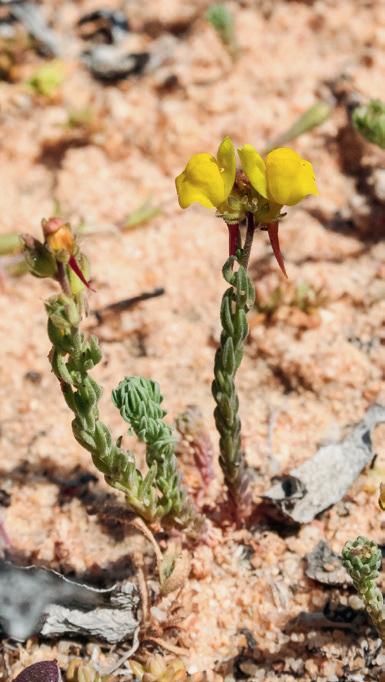
Shrubby Violet (top) and Ficalho’s Toadflax* (Linaria ficalhoana; bottom) are two endemic wildflowers of the Lusitanian coast.
65 FLORA AND FAUNA
FLORA
Common Dolphins are frequent in the waters off Cape St. Vincent and Cape Espichel.
MAMMALS
orchards and vegetable crops and can be such a pest locally that control measures are taken. The smaller Wood and the Western House Mouse are common all over the area. The distribution of the beautiful Garden Dormouse extends from Portugal to the Urals but the species is not common in the woodlands and orchards of our area.
The Rabbit can be found almost everywhere and is locally common. The Iberian Hare is abundant in the steppes and agricultural areas of Setúbal and the Alentejo.
Sea mammals
The Atlantic Ocean off the southern Portuguese coast is frequented by a large variety of dolphins and whales (cetaceans in jargon). Around twenty species have been reported so far. Most of them follow deep chasms and edges of submerged banks and plateaux where they find their prey.
Sometimes, dolphins can be seen from the headlands of Cabo Espichel and Cape St. Vincent but be aware that a telescope, patience and luck are important ingredients for success. Big whales have been reported, but most of the sea mammals remain far from the coast. There are accounts of trawlers being ‘surrounded’ by dolphins. Whether they are true or the proverbial fisherman’s tale remains questionable, but it is clear that your best chance of seeing them is on a boat trip. Fortunately, whale-watching trips are organised from Sagres or Portimão which take you some 15 kms offshore where the cetaceans gather to hunt (see page 213). Sea mammals to be expected on such trips are Common Dolphin (on rare occasions, up to a hundred animals are seen on a single trip), family group of Bottlenose Dolphins and Harbour Porpoise. Your chances of encountering larger whales are decidedly slimmer but from time to time, Minke Whale, Orca, False Killer Whale and Long-finned Pilot Whale are reported.

78 CROSSBILL GUIDES • SOUTHERN PORTUGAL
BIRDS
Birds
Waders, flamingos, spoonbills and other birds of saltmarshes are found on routes 1, 2, 3, 6, 13, 14, 15, 19 and 20. For herons, ducks, Purple Gallinules and other birds of freshwater marshes, visit routes 6, 7, 14 and 15 plus site C and E on page 136-137, A on page 158 and A and B on pages 195-196. For birds of the montados (like shrikes, bee-eaters and Azure-winged Magpies), spend time on routes 2, 6, 8, 9, 10, 11, 12 and 18. Steppe birds are best on route 10, but also on route 8 and sites F and G on pages 161-162. The best raptor routes are 9, 10 and 11 and for seabird watching, try routes 4 and 21. Cape St. Vincent (route 21) is the best for witnessing migration.
Do you want to try the Whiterumped Swifts today or have a crack at the sandgrouse? Take some frame-filling photos of Purple Gallinules or spend some pleasurable hours solving whatis-that-wader-puzzles? Whichever way you turn, southern Portugal is a paradise for birdwatchers. Pretty birds like Bee-eater, Hoopoe and Azure-winged Magpie come by the dozens, while the likes of Bonelli’s Eagle and Rufous Bushchat are real possibilities when you set out to search for them.
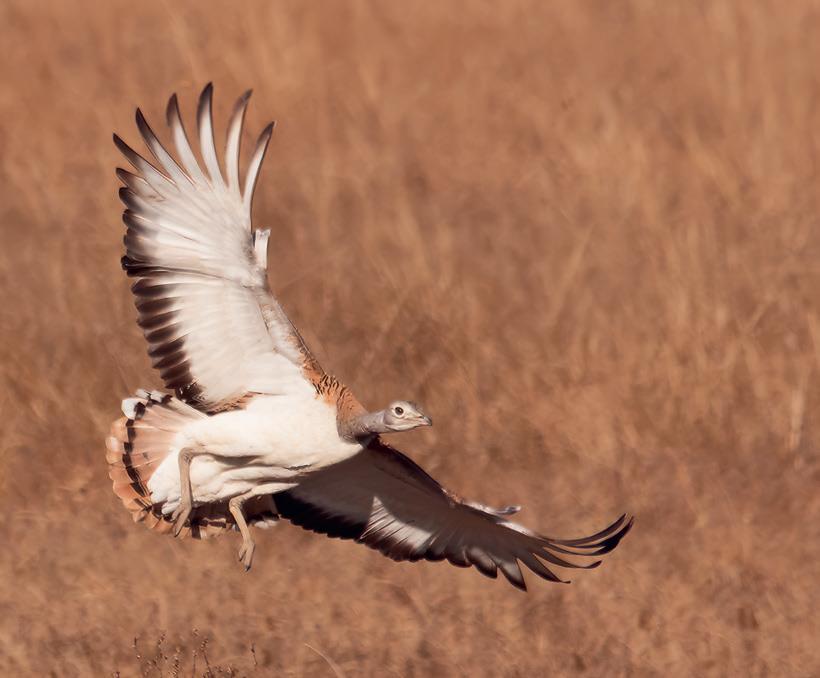
The attraction of southern Portugal as a destination for birders (and other naturalists) is in its variety of Mediterranean species and its Iberian specialities in combination with an unpredictable but rich number of migrating birds in spring and autumn. Seabirds form an attractive distraction, as do the many exotic escapees that have established feral populations. An added bonus is that coastal and inland birding sites are not too far from one another, making it possible to see a lot of different species without having to drive too much. The steppes of the Alentejo are just over an hour’s drive from the Algarve and provide some of the best birding in Europe. Rather unknown and undervalued are the extensive estuaries near Lisbon, which are rich in migrating birds set in rugged surroundings.
Southern Portugal is one of the best places in Europe to see steppe birds like this Great Bustard.
79 FLORA AND FAUNA
REPTILES AND AMPHIBIANS
Reptiles and amphibians
Reptiles and amphibians can be found, at the right time and weather conditions, on nearly all routes. The best habitat for amphibians is found on routes 11, 14, 16, 18, 23 and site B on page 159. These are also the routes to look for Spanish Terrapins and aquatic snakes. Mediterranean Chameleon occurs on routes 12 and 14; Schreiber’s Green Lizard on route 18 and coastal species like Spinyfooted Lizard and Mediterranean House Gecko are best observed on routes 6, 12, 14, 19, 21 and 22.
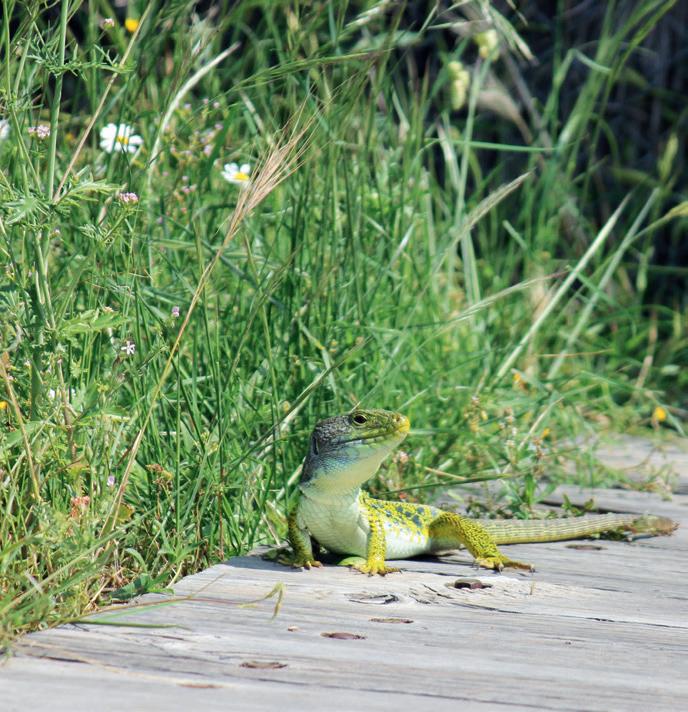
Europe’s largest lizard, the Ocellated Lizard, is spread all over southern Portugal.
There are no less than 35 different species of reptiles and amphibians in southern Portugal, including ten species of frogs and toads, fourteen lizard species, eight different snakes, three terrapins (one of which is not native), plus at least two sea turtles that regularly occur in oceanic waters.
Reptiles and amphibians are usually mentioned in one breath and draw the same audience of naturalists. In life style, though, they are radically different. The amphibians, with their obligatory aquatic larval stage and their drought-and-salt-sensitive skin, find the conditions in the southern Portuguese summers daunting. Most species are only active during the winter season – roughly between October and April. During the dry summer months, they hide deep in the ground. Those that don’t, are restricted to those pools and rivers that never dry out.
For reptiles, the situation is reversed. They need the warmth of the sun and are unconcerned by drought. Hence they are only active during the warmer months, roughly between March and October.
Amphibians
The Iberian (Spanish) Ribbed Newt is, together with the Olm, the largest European newt. It reaches a length of up to and sometimes over 20 cm. It is an endemic of Portugal, Spain and northern Morocco. It has a big head and sharp ribs that form part of a unique defence mechanism in which
92 CROSSBILL GUIDES • SOUTHERN PORTUGAL
REPTILES AND AMPHIBIANS
the venom-coated ribs can puncture the skin through special tubercles to deter would-be predators. This gives the newt a typical and easily distinguishable appearance, although its brownish colour also camouflages the animal well. The Iberian Ribbed Newt lives in and near ponds, pools, streams, riversides and livestock watering places. In the dry season, it hides under stones or underground, sometimes far away from water. It is widely distributed in the area of this book, but it seems not to be very abundant.
The small and aquatic Bosca´s Newt can be identified by its bright, orange underparts. It lives in (temporary) pools and streams and is most abundant in the Algarve hills, the Guadiana Nature Park and other areas with traditional forms of agriculture.
The Southern (Pygmy) Marbled Newt is only found in southern Portugal and south-western Spain. It lives in similar habitat as the Bosca’s Newt but is thinly distributed in the area. It is threatened by the expanding towns and villages and intensification of agriculture.
The brightly coloured Fire Salamander is fairly abundant in the cooler areas with woods and streams. It only comes out at night in the cool season, which makes it a difficult animal to track down. Damp evenings after rainy spells between November and April will offer you the best chances of finding it.
The Iberian Midwife Toad is another endemic amphibian with a distribution restricted to western parts of Spain and the southern half of Portugal. It is an interesting animal because the male takes care of the eggs after they are laid. They arrange the eggs around their hind legs, and keep them moist until they are ready to hatch. Then they are brought to shallow ponds and pools near (temporary) streams. The Iberian Midwife Toad is widely distributed in southern Portugal, preferring open areas away from the coast.
The gregarious Iberian Water Frog is the most common and visible amphibian of southern Portugal. It is the default frog of Portugal, looking like a ‘normal green frog’. It occurs, often abundantly, in any kind of pond, pool or ditch, as long as it doesn’t dry out in summer.
The Fire Salamander is a relict of the fauna of temperate climates, that survives in river valleys with a permanent presence of moisture and shade.

93 FLORA AND FAUNA
ROUTES IN THE LISBON – SETÚBAL AREA
Routes in the Lisbon – Setúbal area
The Lisbon – Setúbal area is little visited by birdwatchers and naturalists from outside Portugal, so this is an insider tip: go there! Its anonymity as a destination for naturalists is completely undeserved. Although this part of Portugal is rather busy and the attractive sites are separated by unattractive areas, this small area has an enormous diversity of habitats and wildlife – one that equals or perhaps even surpasses that of the famous Algarve. Combine the presence of masses of birds and orchids with easy access to Lisbon and other historical towns such as Setúbal and Palmela plus some of the most beautiful and quiet beaches of Portugal, and its attraction as a comprehensive destination is clear.
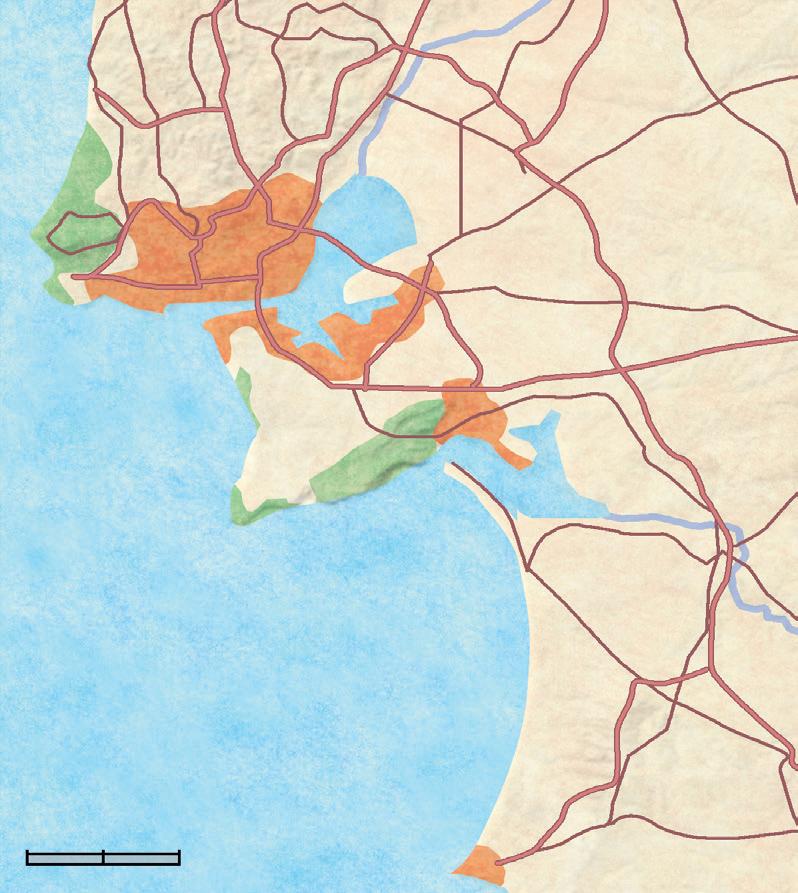
Overview of the Setúbal region. The letters refer to the sites on page 135-140.
The Lisbon – Setúbal area is south Portugal writ small. All important habitats can be found in a compact region: there are extensive fresh and saline marshes, rice paddies and saltpans around two large bays which are the defining elements of the area: the Tejo (Tagus) estuary in the north (routes 1 and 2) and the Sado in the south (route 3 and 6). Birds are the main attraction here as both estuaries collectively form Portugal’s most important wetland area. More freshwater marshes are found around two natural lagoons, that of Albufeira (site E on page 137) and of that Santo André (route 7). Cork oak montados and open pinewoods cover large areas in the east and southeast (e.g. route 6 and 7), while beautiful dunes are found on the Tróia Peninsula and further down (route 6 and 7). Scenically beautiful is the Serra da Arrábida – a limestone range (up to 499 metres), clad in scrubland, pastures, oak and pinewoods that holds a rich flora and butterfly fauna. It is a hotspot for wild orchids (route 3, 4 and 5) and also offers some options for walking. The Lisbon area even has its own 'end of the world headland' in the form of Cabo Espichel (route 4), which has splendid views over the ocean making it a good vantage point for watching seabirds and for scenic walks along the cliffs as you explore the attractive flora and fascinating fossils.
108 CROSSBILL GUIDES • SOUTHERN PORTUGAL setúbal Serra Arrábida b Cabo Espichel montijo costa capparica lisbon sines alcácer do sal alcochete Atlantic Ocean 7 3 1 6 d a c e a12 0 10 km 2 Sado 4 5 Tróia g f h Tejo a 33 a 2 a6 a10 a13 a 2/ e1
Route 1: The Tagus Estuary near Alcochete
HALF A DAY, 13 KM




Observing thousands of waders. Pay a visit to the same spot at low and at high tide to see the
Habitats: estuary, salt marsh, salt pans
Selected species: Shelduck, Flamingo, Osprey, Avocet, Dunlin, Greenshank, Grey Plover, Kentish Plover, Little Tern, Caspian Tern
On both sides of the scenic village of Alcochete, on the south bank of the river Tagus and close to Lisbon, you’ll find bird-rich saltpans and tidal areas with masses of wildfowl, waders, gulls, flamingos and other birds. At low tide, thousands of them feed on the mud of the broad river, which largely falls dry at low tide. Up to 20 species of waders may be seen in a single day during the migration seasons. Winter flocks of Avocet can be impressive, Kentish Plover breeds in several places and Osprey is a regular visitor outside the breeding season. A good telescope and a position on a strategic viewpoint are certainly a good help as birds can be quite distant. This route follows the banks of the Tagus estuary, bringing you to some of the best saline habitat of the region.
Starting point Sitio das Hortas
Getting there
vascodagamabridge

From Lisbon, follow the A12 over the Vasco da Gama bridge. Take exit 3 onto the A33/IC3 towards Alcochete. After a short stretch on the IC3, exit onto the N119 to Alcochete. At the roundabout, go straight (signposted Alcochete). After 2 km, in front of a small restaurant turn right towards Sitio das Hortas (signposted), which you reach after another 1.3 km.
109 PRACTICAL PART 4 1 0 2 km alcochete montijo 2 3 5 lisbon Tejo Bay a12 a 33 n118 n119 ic 3 restaurant
ROUTE 1: THE TAGUS ESTUARY NEAR ALCOCHETE
differences.
Best season Autumn to spring
Sitio das Hortas visitors' centre
1
You can enjoy some superb views over the Tagus as you walk along the coast from here to look for waders and wildfowl. Small fishing boats lie on the beach and at low tide the outgoing water has drawn fascinating figures in the mud, where the birds are scattered in small groups. At high tide you have to search for them roosting on the other side of the small river flowing into the estuary. In winter and on passage Ringed Plover, Dunlin, Little Stint, Knot, Sanderling, Black-tailed and Bar-tailed Godwit, numerous Grey Plover, some Greenshank, hundreds of Redshank and Whimbrel as well as Turnstone join the resident Kentish Plovers. Little Egret and Grey Heron may wade in the shallows and Shelducks swim in the creeks. Further out there are lots of gulls, especially in winter when Lesser Black-backed and Black-headed Gull are abundant. Numbers of wintering Avocet vary from year to year, while Flamingo can number in the hundreds. Terns are mostly seen on migration, with Black, Sandwich and Caspian Tern the most noteworthy.
D rive back to the small restaurant, turn right and enter the fishing town of Alcochete. Find a place to park your car on the boulevard.
2
Check the shoreline for waders at low tide and walk the 250 m long pier, where birds can be seen from up close. You can expect the same species as at Hortas and enjoy better views over the Tagus River Estuary Natural Reserve with Lisbon beyond.
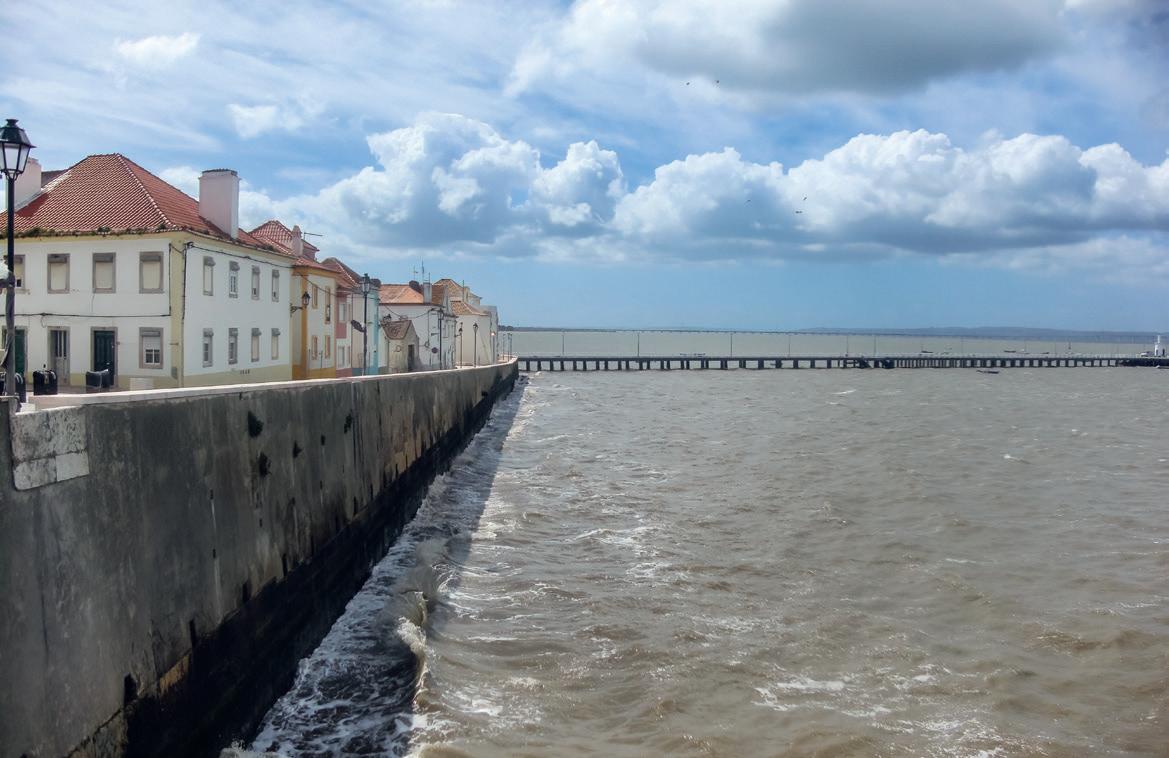
110 CROSSBILL GUIDES • SOUTHERN PORTUGAL
ROUTE 1: THE TAGUS ESTUARY NEAR ALCOCHETE
The quay of Alcochete.
Continue along the boulevard of Alcochete in western direction. Continue all the way until you arrive at a roundabout. Go right and follow the street as it bends to the left. At the next roundabout go right. The tarmac makes way for a cobbled road. At the next one roundabout (following shortly after the previous) go left and continue to the Salinas do Samouco (GPS 38.743592, -8.981271).
3The Samouco saltpans (360 ha.) were expropriated and given to a foundation with the objective to conserve its birdlife as compensation to the building of the Vasco da Gama bridge (almost 14 km from end to end). About 5% of the wintering birds of the Tagus estuary use this relatively small area, either to feed or as a high tide roost. There are several places where you can stop along the road and enjoy views over the fenced saltpans. Similar birds as at the previous sites can be seen. In addition, Black-winged Stilt breeds here (up to 314 nests), as does Little Tern (up to 134 nests) and Kentish Plover. On the lagoon edges, look for Great Cormorant, Grey Heron and Sandwich Tern as well as small numbers of Pied Wagtails (alongside White Wagtail) on migration.

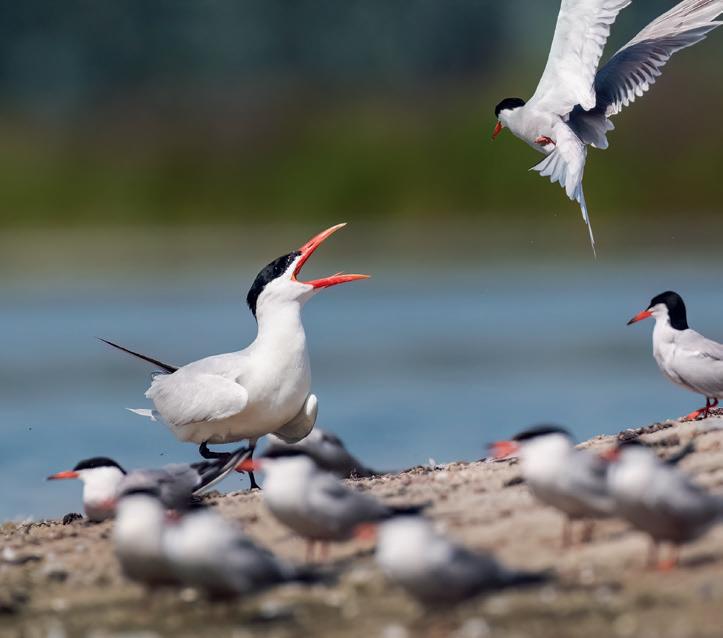

The tidal marshes near Alcochete are full of birds, especially during migration. Dunlin (top) and Caspian and Common Terns (centre) are just three of the species to be found.
At low tide, clamdiggers cross the mudflats to search for shellfish.
111 PRACTICAL PART ROUTE 1: THE TAGUS ESTUARY NEAR ALCOCHETE
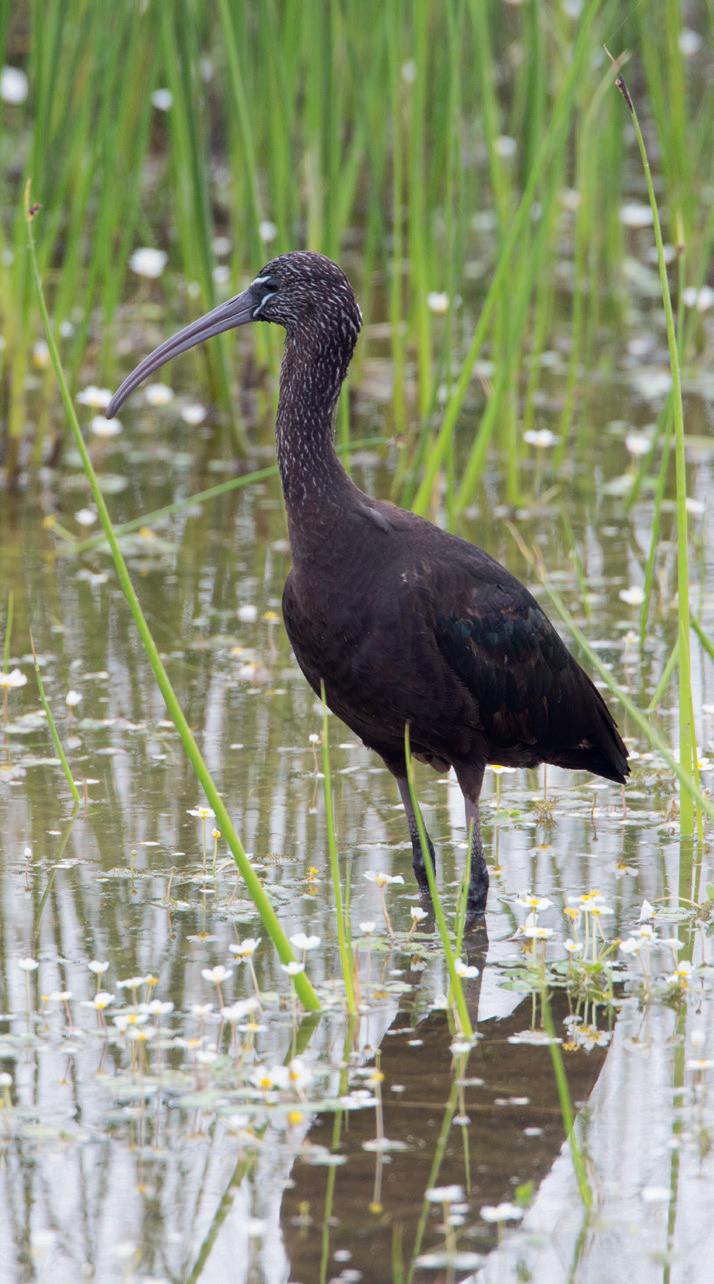
From autumn to early spring, you can see thousands of Glossy
Ibis in the marshes and rice paddies along the Sado River.
Clam fishing
4 T he road ends at the nearby beach (GPS: 38.744829, -8.982070), which is another good area to search for waders, plus Shelduck, Shoveler, Wigeon and other wildfowl and gulls (including Mediterranean Gull in autumn and winter). There are a few low dunes where Hoopoe, Black Sardinian Warbler and passage migrants c an be found.
G o back to the second roundabout and turn right onto the M501 that runs along the southern edge of the salt pans. Unfortunately, it is difficult to park along this road, so continue and follow the road underneath the A12 motorway to the village of Samouco. At the roundabout in the village, turn right on (direction base aérea no 6 ) and at the next, right again (Praia Fluvial ) to reach the coast again.
5
Views from here over the muddy Tagus estuary are again superb. There is a wide creek to your right where birding is interesting. At low tide you’ll see the clam fishers out on the mudflats.
Clam fishing or clam digging is a generic term for harvesting molluscs that live in or on the mud. The most important species that are caught in the Tagus estuary are Clam (Ruditapes decussatus) and Oyster (Crassostrea angulate). Clam fishers go out at low tide, equipped with spade or fork to dig out the shellfish, which are cleaned and put in a bag. Clam fishing is laborious work but worth the effort as the clams are considered a delicacy in Lisbon and restaurants are willing to pay a good price for them. Thousands of people earn some money digging clams. Clam fishers are very active at the Tejo and Sado estuaries, but also in the Algarve, such as at Alvor.
112 CROSSBILL GUIDES • SOUTHERN PORTUGAL
ROUTE 1: THE TAGUS ESTUARY NEAR ALCOCHETE
Route 2: The Tagus Estuary near Barroca d´Alva and Pancas
FULL DAY, 37 KM


Great birdwatching. Possibly the best site for naturalized exotic birds.



Habitats: marshland, reedbeds, Cork Oak woodlands, rice fields, grassland
Selected species: Waxbill, Black-headed Weaver, Yellow-crowned Bishop, Black-headed Munia, Booted Eagle, Bee-eater, Red-necked Nightjar, Iberian Chiffchaff, Iberian Hare Best season
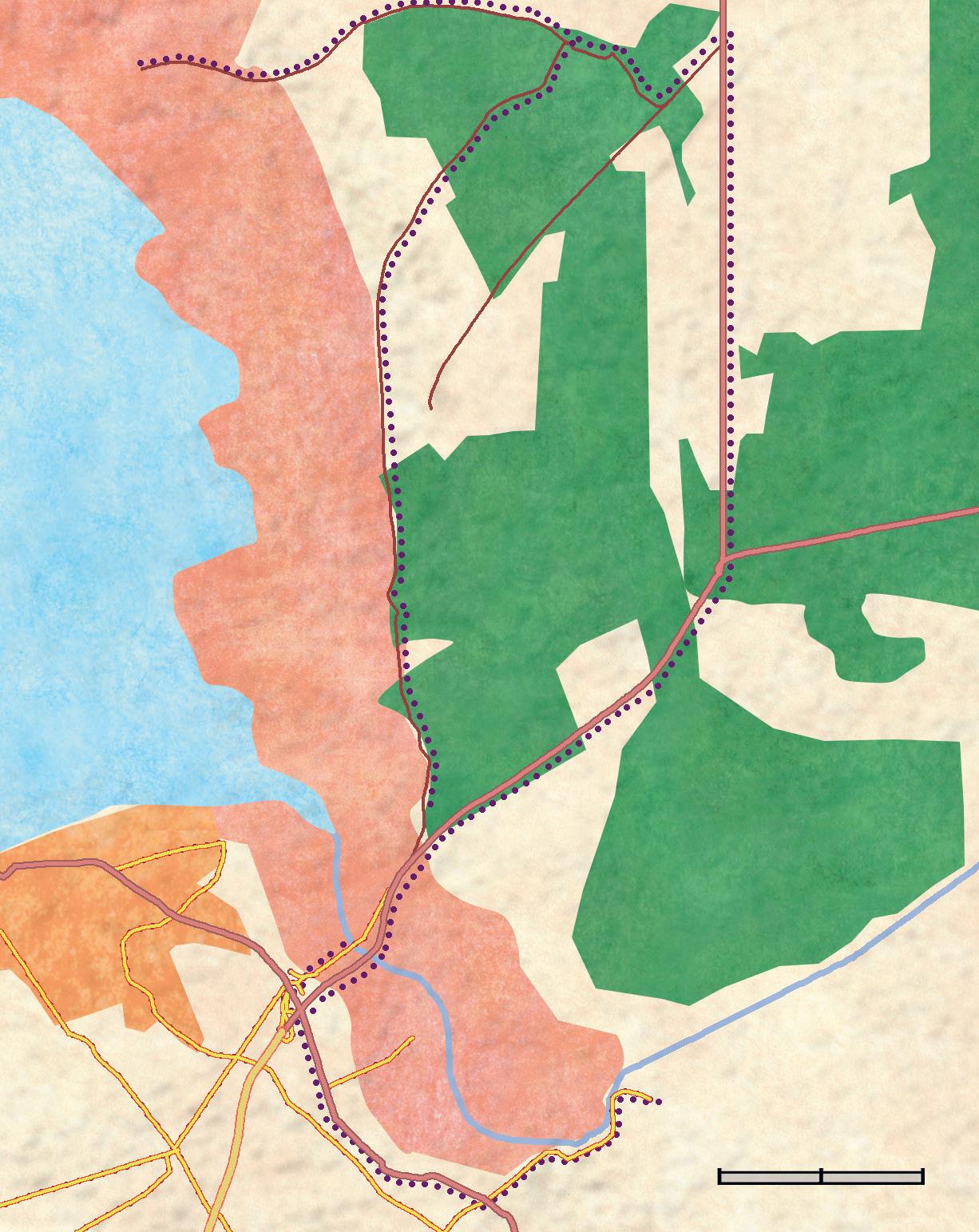
A little inland from the Tagus Estuary, you’ll encounter a very different landscape than that of the shores you visited on route 1. Here it is reedbeds, rice paddies and cork oak montados that form the key ingredients. This route combines two very different sites that are some 20 kms apart. First, you’ll explore the surroundings of the hamlet Barroca d´Alva (also called Paul da Barroca) which is one of the best sites to see Portugal´s naturalised exotic birds – Common Waxbill, Black-headed Weaver, Yellow-crowned Bishop and Black-headed Munia. Some of them even form large roosts, taking advantage of the seeds of reedbeds and the dense herbal vegetation along the watercourses. The second part of the route explores the dry fields and cork oak montados in the eastern section of the area. Both sites are predominantly interesting for their birdlife.
Starting point Barroca d’Alva
113 PRACTICAL PART
7 3 alcochete Catapereiro 2 0 2 km 1 coruche montijo / a12 pegões porto alto samora correia n118 ic 3 4 6 Tejo Bay Sitio das Hortas visitors' centre 8 ROUTE
THE
ESTUARY NEAR BARROCA D'ALVA
2:
TAGUS
AND PANCAS
Autumn
to spring
Pancas
Barroca d'Alva
5
Bate Orelhas
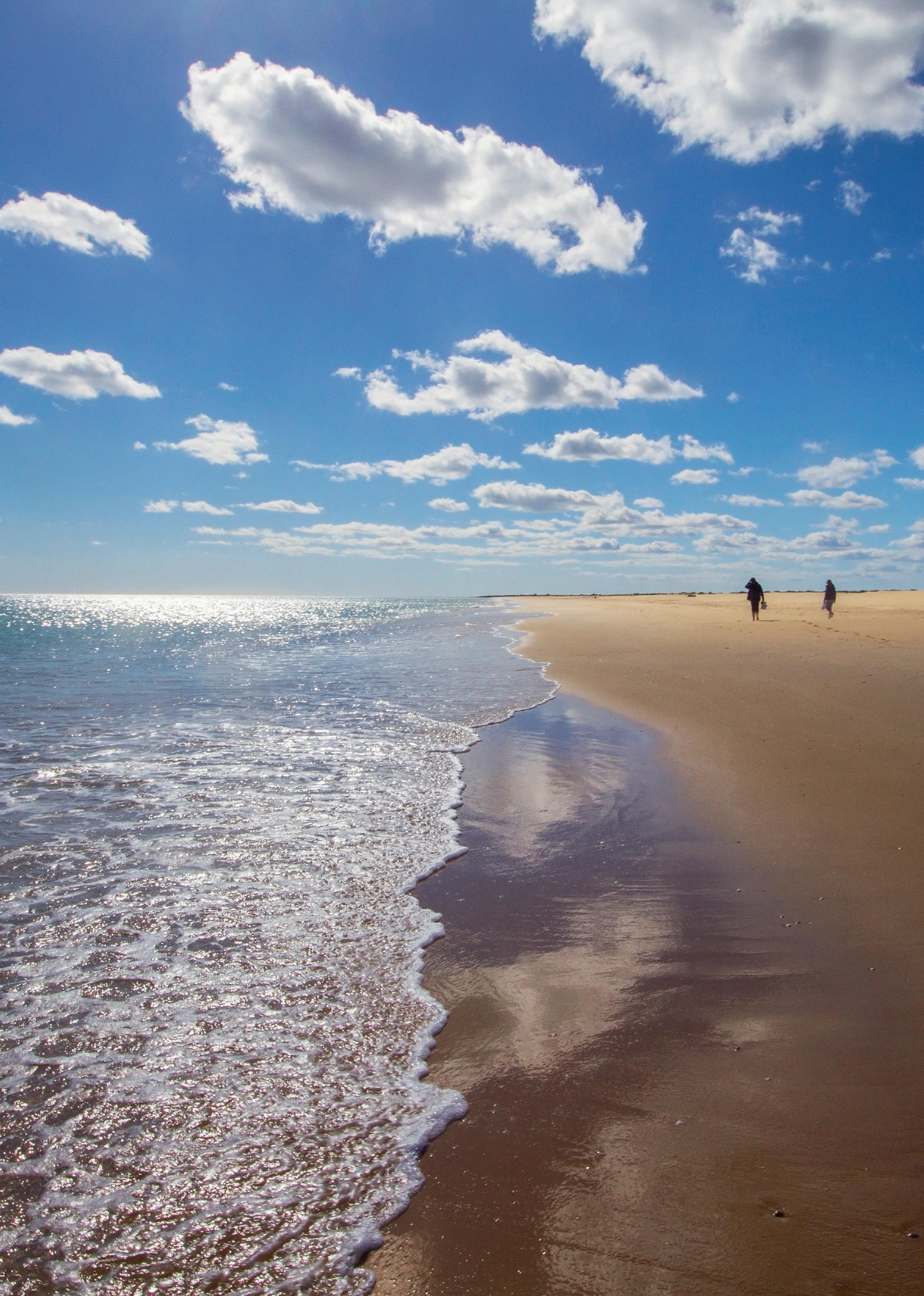
TOURIST INFORMATION & OBSERVATION TIPS
Travel
Travelling to southern Portugal
There are currently three practical ways to get to southern Portugal: by plane, bus or car. Lisbon was also served by a night train from Madrid, called Trenhotel Lusitania, but this service was terminated during the Covid pandemic and since when it seems to be defunct. However, it may be worth checking rail connections following promised EU funding. There are cheap and fairly fast buses from Madrid to Lisbon, though – see www.omio.com or www.flixbus.com. There are also daily flights that connect Lisbon and Faro to most European airports, all of which have the disadvantage of more excessively contributing to climate change, which is already greatly impacting southern Portugal. Drivers from the UK can reduce their driving time by taking a ferry to northern Spain.
The drive to southern Portugal from northern Europe takes a long time (over 20 hours driving time from the Channel ports and 8 hours for those arriving from the UK via Santander ferry). Once arriving in Portugal, it is worth using the toll roads to Lisbon or the Algarve. They are quiet, well-maintained and much faster than taking the backroads. The fastest route is to drive first to Madrid and take the A-5 to Mérida (in Extremadura). There, you have three options. The first is to go directly to Portugal by the toll road near Badajóz. From here, you can either explore the Lisbon – Setúbal area or enter the Alentejo. The next option is to drive south to Zafra, take there the small Ex-101 and enter Portugal at Barrancos (route 9) in the Alentejo. Finally, you can head south to Sevilla and enter the Algarve on the A22 which is conveniently close to Castro Marim (route 13).
Travelling in southern Portugal
The car is by far the easiest means of transport in Portugal. Driving the motorways is easy, comfortable and progress is fast – the backroads however, are the exact opposite – they are long and winding, although the state of repair is generally good. Traffic is light overall, except in the Lisbon area and the main routes in the Algarve during the tourist season. The towns just south of Lisbon, on the banks of the Tejo are all suburbs from which people commute into Lisbon. In this area traffic is busy and sometimes a bit chaotic. So, if you plan to head into Lisbon, do as many other locals do and take a bus or train from the suburbs.
217 TOURIST INFORMATION & OBSERVATION TIPS
Toll roads
Toll roads in Portugal are a little complicated because there are two systems. Some roads will have the familiar toll booths where you get a ticket and pay, either by cash or credit card, as you leave the motorway. Others have an electronic toll system, which is activated by a box in your rental car. When you pass an electronic toll sensor, you will hear a soft bleeb from the box to inform you are being charged. The rental company will probably offer you a system by which these charges are directly debited from your credit card. This saves a lot of hassle. If you don’t choose this option, you must pay at a post office. However (and here’s the rub), there is an administrative delay of 2 days before the charge is processed so that you can then pay the amount due at the post office. Hence you will incur an extra charge (plus a hefty service fine) from your rental company if you use these roads in the last two days of the hire period. If you bring your own car, which doesn’t have the box installed, you are not charged at all. Toll costs are similar to those in Spain and France – in 2024, the drive from Badajóz to Lisbon was € 17.85. You can calculate your toll costs at www.tollguru.com/ toll-calculator-portugal
Southern Portugal by bus and train
Portugal has good public transport system, that, if you don’t mind taking your time, will give you a good start in exploring the country’s natural areas. However, it can’t match driving a car for speed and convenience. The railroad system (www.cp.pt) will take you to the most important towns (Lisbon, Setúbal, Beja, Faro, Lagos, etc), but you’ll need the bus to get you deeper into the countryside. The national bus service is RENEX which serves all the major towns (check www.rede-expressos.pt). There is also a fine network of local bus networks in the Algarve (www.eva-bus.com), the Alentejo, (www.rodalentejo.pt) and in the Setúbal area (www.tsuldotejo.pt).
Cycling in southern Portugal
Cycling in Portugal has its challenges, but also its rewards. The interior of the Algarve and Alentejo is beautiful and quiet (away from the easily avoided N-roads), but towns and facilities are few and far between, requiring careful planning. Also, be aware that shade is sparse. The landscape is hilly but not at all too challenging, just enough to remain pleasant. The roads are generally good for cycling. Don’t expect any facilities for cyclists, but as traffic is sparse, that shouldn’t be a problem.
The Lisbon-Setúbal area and the coastal Algarve is radically different. Here are no facilities for cyclists either, but because traffic is busy and in places a little chaotic, it requires extra care. The upside is that there is plenty of accommodation. In all regions, winter, spring and autumn are the most pleasant, as temperatures are less challenging and traffic is less chaotic (except around Lisbon, where it is always busy).
218 CROSSBILL GUIDES • SOUTHERN PORTUGAL
Ferries
There are ferries across the Tejo from Lisbon and Sado near Setúbal. The Setúbal –Tróia service is by Atlantic Ferries (www.atlanticferries.pt). You don’t need to book online. Just go to the port and queue up. In our experience, it is not busy, except, sometimes, at weekends and on holidays.
There is also a ferry from Lisbon to Cacilhas, just north of Costa Caparica (which is connected by bus) and you can make a trip from Lisbon to Montijo (site D – Montijo harbour, see page 137). For more information, see www.transtejo.pt. Ferry trips are comfortable and often offer good birdwatching and, in season, chances on seeing dolphins.
Planning your trip
When to go
Southern Portugal is of interest throughout the year, although the summer season, when it is exceedingly hot and wildlife is shy, is the least rewarding.
Winter is the rainy season, but even then rainy spells usually last no more than a few days between prolonged periods of mild and sunny weather. The warm Gulf Stream has a major influence on the climate of southern Portugal, making its winters among the mildest in the whole of mainland Europe. November to February is a great season for birding. The wetlands on the coast are chock-a-block with wintering wildfowl that have fled the cold in northern Europe. The rice paddies are flooded, attracting thousands of waders and ibises. Since many of the Alentejo’s birds are residents, the interior of our region is attractive in winter too (although not as good as spring). Late autumn to early spring is the best period for finding amphibians as well. These moisture-loving creatures spend the hot months hidden in the soil, but are active in the cooler, wetter months.
Due to the mild and stable climate, spring comes early, with narcissi, orchids and other bulbs starting to bloom in late February. The first reptiles also appear and early migrants (storks, Great Spotted Cuckoo, Swallows) are returning. March is a splendid month, with masses of wildflowers and orchids appearing everywhere. Spring butterflies like Spanish Festoon are on the wing. March is an important month for spring migrants, although April is still richer. For birds April and May, when all migrant birds arrive, are arguably the best months for bird-watching, although the rice paddies are drained, so there are fewer birds in the marshes.
From mid-May onwards, the countryside starts to turn brown as the wildflowers start to wither. Since there are no high mountains in the region, there is no prolonged period of blooming. From mid-May, a number of attractive dragonfly species appear in the rivers and late-arriving birds like White-rumped Swift and Rufous Bush Robin
219 TOURIST INFORMATION & OBSERVATION TIPS
Ecotourism code of conduct
We appeal to every naturalist, birdwatcher and nature photographer to abide by this code of conduct in the interests of birds, wildlife and their environment.
• Learn patterns of animal behaviour – know when not to interfere with an animal’s life cycle.
• Acquaint yourself with the fragility of the ecosystem – stay on trails that are intended to lessen impact.
• When out in the field, use good judgement – treat the wildlife, plants and places as if you were their guest.
• Treat other observers and photographers courteously – ask before joining others already in an area.
• Keep distance to the birds to avoid stressing or exposing them to danger, exercise restraint and caution during observation, photography, sound recording or filming. Use appropriate lenses to photograph wild animals – if an animal shows stress, move back and use a longer lens.
• Keep well back from burrows, nests, colonies, roosts, display areas and important feeding sites. Do not handle birds, chicks or eggs unless for recognised research activities.
• Before advertising the presence of a rare species of plant or animal, evaluate the potential for disturbance, its surroundings and other people in the area, and proceed only if access can be controlled, disturbance minimized, and, where applicable, permission has been obtained from private land-owners. Unless officially publicised, the sites of rare nesting birds should be divulged only to the proper conservation authorities.
• Do not enter private property without the owner’s explicit permission.
• Tactfully inform others if you observe them engaging in inappropriate or harmful behaviour – many people unknowingly endanger themselves and animals. If this doesn’t help, report inappropriate behaviour to proper authorities.
• Be a role model – educate others by your actions; enhance their understanding.
• Support the protection of important bird habitat.
Also linked to the climate, is water consumption. The high water demand during the warm months is the reason that so many large reservoirs have been constructed and new ones are planned. So be conservative in your use of water (although don’t stint in keeping yourself hydrated). It is your water consumption, added to that of all other tourists, that creates the demand that puts the ecologically devastating dam-building projects on the agenda. The greatest other water consumer, apart from agriculture, is the golf industry. Our preference here is simple; don’t play golf. Instead, spend your money in more sustainable economic endeavours: ecotourism and the consumption of local produce. The production of cork, carob, honey and locally produced meat and cheese sustains the biodiverse landscape of southern
222 CROSSBILL GUIDES • SOUTHERN PORTUGAL
Portugal. Purchasing these products are a direct support to nature conservation. Indirectly, your presence and spending shows governments and local communities alike that the environment and its associated wildlife have an economic value in the form of sustainable green tourism, a pragmatic argument that usually carries more weight than appeals to beauty, a landscape’s historical significance or the intrinsic value of nature. Local B&Bs or hotels in the countryside are a better (and much more enjoyable) choice than impersonal tourist apartments or hotel chains. When exploring the Algarve, consider the more pleasant option of staying in a rural B&B (mostly north of the motorway) rather than in the tourist resorts at the coast. When out in the field, avoid damaging activities. Hiking, cycling, a canoe or a drive through the countryside are fine. Off-road quad ‘adventures’ as frequently advertised, are not. Especially in the Algarve, such trips often go to the few remaining wild sites and are potentially very damaging.
Hiking in southern Portugal
Hiking has been in vogue in southern Portugal only recently. However, unlike the north of the country, southern Portugal is not a great hiking region. It is too hot for much of the year and many areas in the interior and south coast have few hiking trails and are a bit too monotonous for pleasant walks.
The great exceptions are the Rota Vicentina and Rota Algarviana – two multiple-day and in places demanding, long distance trails. The Rota Vicentina follows the wild south-west coast. In several places along this route, there are shorter loops for full or half day treks. The Rota Algarviana crosses the Algarve hills from east to west. Both trails meet at Cabo São Vicente.
In several other places in the Algarve there are short walks, such as at Fonte de Benémola (route 16) and Rocha da Pena (route 17). The Serra de Monchique is also plugged as a hiking area with trails available in the tourist office of Monchique village, but much of this area is so thoroughly vandalised by Eucalyptus plantations that hiking is only recommended in the small areas around both peaks of the range (see route 18). The brochures of the Baixo Alentejo list a number of hiking trails in the area, but many of them either follow (linear) tracks or roads through open country, or are small trails that only seem to exist on paper. Positive exceptions are near Barrancos (route 9).
If you plan on hiking in southern Portugal, make sure you bring a GPS device or a fully charged phone with good maps on it, to prevent getting lost (or failing that a compass and good maps). Signposting is, in places, poor and trails, consequently, may not be easy to find. The mobile phone network does not cover all the little corners in the area, but is good overall. Furthermore, make sure to bring sufficient food and water and precautions against exposure to the sun (see page 221).
For further details, see www.walkalgarve.com (English) or www.wandeleninportugal.info (Dutch).
223 TOURIST INFORMATION & OBSERVATION TIPS
Pheasants and partridges Red-legged Partridge is common in all rural and agricultural areas, especially in the Alentejo (e.g. 8 – 11). Quail is common in cereal fields. Divers and grebes All divers are extremely rare at sea in winter. Black-necked Grebe is a winter visitor in the Atlantic and the mouth of the estuaries. Little Grebe is a widespread resident in wetlands, also in small freshwater pools. Great Crested Grebe is a scarce breeding bird along reservoirs and lagoons. Their numbers increase in winter (e.g. 7 and at Salgados; site A on page 195).
Cormorants, shearwaters, storm-petrels and Gannet Seabirds are abundant on the Atlantic Ocean off southern Portugal especially in autumn and in winter. Passage of seabirds can be observed from Cape St. Vincent (21) and Cape Espichel (4). Gannet, Cory´s and Balearic Shearwater are possible pretty much all year but most abundant at the end of summer and in autumn. Great Cormorant is an increasingly common winter visitor. Shag breeds along coasts with rocks and cliffs and is present all year (4, 21, site H on page 214). Other seabirds are only regularly seen from pelagic boat trips.
Herons Little and Cattle Egret are the most abundant of the herons. Little Egret is fairly common in all kind of wetlands, the coastal saltwater estuaries, the inland freshwater wetlands and the along the rivers. Cattle Egrets are abundant in fields, where they take advantage of cattle that flush up insects. Groups of Grey Herons can be seen in good numbers in the Tejo and Sado estuaries (1, 2, 3, 4), in smaller numbers in the Algarve coastlands, while single birds are found along the rivers. Great White Egret is a wintering bird on the coast in small but increasing numbers. Purple Heron and Little Bittern breed and are mostly confined to reedbeds (15, Albufeira; E on page 137, and Salgados and Vilamoura; A and B on pages 195196). Night and Squacco Herons are quite scarce (best 6).
Storks White Storks are very common and conspicuous throughout the region, often breeding in roadside trees, electricity pylons and of course in the villages. Remarkable is the off-shore colony on the stacks of Cabo Sardão (site H, page 214). Many birds stay all winter. Black Stork breed along the Guadiana river (11, less so 8, 9, B and E on pages 159-160), During autumn migration, their numbers increase and they’ll visit other wetlands too.
Ibisses, Spoonbill and Flamingo Glossy Ibis can be seen in winter and spring by thousands in rice fields and by hundreds in other wetlands (2, 6, 7 site C on page 136, F on page 139, A on page 158). Spoonbill returned as a breeding species in the 1980s and is found in groups of up to several dozens in the estuaries and coastal wetlands (1, 2, 3, 6, 13, 14, 15 and inland, site A on page 158). Their numbers peak in the passage periods. Greater Flamingo does not breed, but is year-round present in the estuaries (1, 2, 3, 6, 13, 14, 15).
Vultures The Egyptian Vulture no longer breeds in the Guadiana basin, but birds appear during autumn migration (21). Many Griffon Vultures visit the Alentejo
232 CROSSBILL GUIDES • SOUTHERN PORTUGAL
(9, 10) throughout the year, with fewer numbers in the Algarve mountains (18, 21). The same goes for Black Vulture, only in smaller numbers. Eagles and other broad-winged raptors Short-toed and Booted Eagle occur throughout during the breeding season, both in low numbers (e.g. 2, 3, 4, 8-12). Some Booted Eagles winter. Bonelli´s Eagle breeds in the Serra da Arrábida, Guadiana valley and in Monchique mountains and non-breeding birds disperse over a wider area (e.g. 4, 5, 9, 10, 11, 18). A small but increasing population of the Spanish Imperial Eagle breeds in the Guadiana valley and non-breeding birds are seen in a wider area (e.g. 9, 10, 18). Golden Eagle can be seen at the Guadiana near Barrancos (9, 10, 11 and 21). During migration and in winter the Osprey can be seen at estuaries and wetlands near the coast (e.g. 1, 2, 3, 6, 7, 13, 14, 15). The Buzzard is a resident in low numbers but the Honey Buzzard appears only during migration. Black Kite breeds all over the region, but Red Kites are restricted to the Guadiana valley and near the Costa Vicentina (8-12, 21, 22). Their numbers greatly increase in winter. The Black-winged Kite is widespread in the Setúbal region and the Alentejo (1, 2, 3, 6, 8, 9, 10, 12). After the breeding season it also appears in the Algarve. Small numbers of Marsh Harrier breed in wetlands with reeds (e.g. 2, 3, 6, sites E (Albufeira) on page 137 and B (Vilamoura) on page 196).
A few pairs of Hen Harrier may still breed (8, 9) and their numbers increase in winter when they may feed on the same fields as Marsh Harrier (10). Montagu´s Harrier can be seen on the steppes and cereal fields (e.g. 8, 10, 13, site A (Lagoa dos Patos) on page 158 and F (Azinhal) on page 161).
During winter and migration Goshawk and Sparrowhawk can be seen in wooded areas, but only very few breed.
Falcons The Lesser Kestrel is almost entirely restricted to the Castro Verde – Mértola area (10, E on page 160) where it is easy to see in spring/summer. After the breeding season it shows up in the Algarve and at Cape Espichel (e.g. 4, 21). Common Kestrel is a widely-distributed resident. The Merlin is a winter bird (e.g. 10), while the Hobby is mostly seen on migration (e.g. 21). Only a few pairs breed. Some Peregrine Falcons breed, more are seen in winter and during migration (e.g. 2, 10, 21, C on page 196). A few Eleonora´s Falcon are seen during spring (rare) and autumn (more regular) migration (e.g. 21).
Rails and coots Water Rail is mainly found in coastal marshes and the Tagus estuary. Crakes are very rare (e.g. site E (Albufeira on page 137), A (Salgados on page 195). Moorhen is locally common. Purple Gallinule is recovering and resident in reeds (6, 7, 15 and site E on page 137 and site A on page 195). Common Coot is common, with high numbers in winter (e.g. 7). Long absent, a handful of Crested Coot have been recorded in recent years (e.g. 2; Tagus estuary).
Common Crane and bustards Cranes are common winter birds in the eastern Alentejo (8, 9). Small numbers may turn up elsewhere. Little and Great Bustard
233 TOURIST INFORMATION & OBSERVATION TIPS
Sparrows Tree Sparrow is widespread but scarce. House Sparrow is common everywhere. Spanish Sparrow has increased recently, and can be found in the eastern Alentejo and Algarve (8, 9, 10, 12 and sites D and E on pages 159-160). Rock Sparrow is more widespread (8, 12), but uncommon and largely absent from the southern Algarve.
Finches Chaffinch, Serin, Greenfinch, Goldfinch and Linnet are all common and widespread in open woodland and farmland. In winter, low numbers of Brambling and Siskin appear. Hawfinch is a scarce resident in oak forests and more widespread in winter (Site F on page 139, site A on page 158 and site E on page 160). Crossbill sporadically appears in winter as does Bullfinch.
Buntings Cirl Bunting lives in open woods and riverine forests (3, 4, 9, 11, 17, 18 and Albufeira; site E on page 137). Rock Bunting is resident in rocky terrain with herbal vegetation (4, 9, 11, 13, 17, 18 and along the Guadiana (sites B and E on pages 159160)). Corn Bunting is abundant in cereal fields and steppes. Reed Bunting winters in reedbeds (7, 15, and freshwater lagoons on site E on page 137 and A and B on pages 195-196). Ortolan Bunting is a scarce migrant.
Exotics The list of exotics of southern Portugal is long. No less than 55 species have been recorded, but only few species have established populations. Among these are Crested Myna which lives in the Lisboa-Setúbal area (e.g. 4, site B on page 135), Common Waxbill (2, 3, 6, 15, 18, 23 and site B on page 196) and Black-headed Weaver (2, 6, 15, site A on page 195) are found in wet and bushy habitats. Confusingly, a few Village Weavers, sometimes also called Black-headed Weaver, have also been reported in reedbeds. Yellow-crowned Bishop (2, 3) is seen in coastal wetlands and Chestnut Munia is mainly found at the Ria de Aveiro (but many have been retrapped for the cagebird trade). Remarkably, a small population of Pin-tailed Whydah, a brood parasite (like Cuckoo), has persisted for some years at Ria de Aveiro by using Common Waxbill as a host. Red Avadavat is established around Elvas (Alentejo) and the Barroca marshes near Lisbon but has also been reported elsewhere. Rose-ringed Parakeets are well established in Lisbon. Monk Parakeet is less common but breeding has been reported from Lisbon and Faro.
238 CROSSBILL GUIDES • SOUTHERN PORTUGAL
ACKNOWLEDGEMENTS
Over the years, the Crossbill Guides Foundation has gathered a large group of naturalists, some of them authors themselves, who have supported us by gathering information, proof-reading, offering photos and so on. Without them, this book good not have been made.
We thank the Bert Snijder and his family, local resident and bird guide for his support, information and excellent photographs that he provided for this guide. Ivo Rodrigues for taking us out and sharing his butterfly and orchid sites in the Alentejo with us.
Another thank you for Constant Swinkels, who helped us greatly with assembling the route maps. The Crossbill Guides veterans Kim Lotterman, John Cantelo, Gino Smeulders and Albert Vliegenthart have enriched this guide greatly by checking and complementing the flora, birds, geology and insect chapters respectively. In addition, Kim took upon himself the precise work of creating the species list, while Albert wrote for us the ‘other invertebrates’. John meticulously checked all the routes and the bird and historical information and Brian Clews edited the manuscript before going to print. Thanks for all your hard work.
Furthermore, we wish to thank our illustrator Hortst Wolter and all the photographers whose collective work makes you want to see all of southern Portugal’s splendour for yourself. Thank you Bert and Eline Snijder, Mark Zekhuis and Bart Vastenhouw, the Saxifraga foundation, Albert Vliegenthart, Wil Luiijf, Rob Mooser, Jörg Mager, Luc Hoogenstein, Kim Lotterman, Cor Fikkert, Frank Jouandoudet, Jan Sohler, Carlos Sanz and Bouke ten Cate.
Finally, we thank of course our own families, in particular Kees’ Pilar Uriarte and Dirk’s Oscar Lourens, for your continuous support, both at home and in the field. And of course for making the production of this book such a pleasurable experience.
For our 2024 reprint we checked and updated the routes. Some of these checks we did ourselves, but for others we are greatly thankful to Berndnaut Smilde and Annegret Kellner, who walked some of the routes and checked some sites in the Algarve.
Dirk Hilbers and Kees Woutersen February 2024
239 TOURIST INFORMATION & OBSERVATION TIPS
PICTURE AND ILLUSTRATION CREDITS
In the references that follow, the numbers refer to the pages and the letters to the position on the page (t=top, c=centre, b=bottom, with l and r indicating left and right).
Crossbill Guides / Cate, Boute ten: 174
Crossbill Guides / Hilbers, Dirk: 4 (2nd and 4th from above), 5 (all), 10, 13, 17, 22 (t+b), 23, 28 (t+b), 29, 30 (t+b), 33, 34, 35, 39 (b), 41, 42, 43, 44 (b), 46, 49 (b), 50 (t+b), 51, 52, 54, 60 (t+b), 63, 64, 65 (t), 66, 68 (t, c, b), 69, 70, 71 (t+b), 72 (t, c, b), 81, 84 (t), 96, 100 (t+b), 104 (b), 106, 119, 120 (b), 121, 123 (t+b), 124 (t+b), 125, 127 (t, c, b), 129, 130, 133 (t), 134 (t, c, b), 146 (t+b), 147 (t+b), 149, 153 (t+b), 155 (t, c, b), 157 (t+b), 160 (b), 163, 165, 166 (t + b), 167 (b), 173, 175 (t, c, b), 177 (b), 177 (t+b), 179 (t+b), 181 (t+b), 183 (t, c, b), 185, 187, 188, 197, 198, 201 (t, c, b), 202 (t+b), 203, 204 (t+b), 207 (t, c, b), 208, 210 (t+c), 211 (t+b), 212 (t+b), 213, 215, 216
Crossbill Guides / Lotterman, Kim: 65 (b), 67 (l+r), 93, 138 (l)
Crossbill Guides / Swinkels, Constant: 210 (b)
Crossbill Guides / Vliegenthart, Albert: 101, 102, 103, 105 (t+b), 120 (t+c), 156, 161, 167 (t), 211 (c)
Crossbill Guides / Woutersen, Kees: 4 (3rd from above), 15, 24, 26, 32, 40, 49 (t), 56, 75, 76, 92, 110, 111 (b), 115 (b), 131, 135, 143, 169, 186, 190 (t), 191, 193, 195, 196
Fikkert, Cor: 36 (t), 87, 111 (t+c), 133 (b), 136, 138 (r), 170, 190 (b)
Hoogenstein, Luc: 112
Jouandoudet, Franck: 74
Mager, Jörg: 39 (t), 77 (b), 82 (b), 83, 85, 88, 115 (t), 144 (t), 148, 151
Mooser, Rob: 116
Luiijf, Wil: 94
Sanz, Carlos: 98, 171
Saxifraga / Kruit, Rik: 78
Saxifraga / Vastenhouw, Bart: 194, 205
Saxifraga / Zekhuis, Mark: 27
Sohler, Jan: 84 (b)
Unknown artist: 48
Uriarte, Pilar: 25
Vogels Portugal / Snijder, Bert (www.birdwatchingalentejo.com): 4 (t), 36 (b), 37, 44 (t), 58, 79, 80, 82 (t), 86, 89, 90 (2nd and 4th from top), 91, 114, 144 (b), 152, 159, 160 (t), 178, 210 (t)
Vlinders Portugal / Snijder, Eline (www.vlindersportugal.nl): 99, 104 (t), 140
Commons.wikimedia.org / Charlesjsharp – Sharp Photography, CC BY-SA 4.0: 90 (3rd from top); https://commons.wikimedia.org/w/index.php?curid=53930240
Commons.wikimedia.org / Photo by Laitche – BY-SA 4.0: 90 (t)
https://commons.wikimedia.org/w/index.php?curid=42188975
All illustrations by Crossbill Guides / Wolter, Horst
240 CROSSBILL GUIDES • SOUTHERN PORTUGAL
SPECIES LIST & TRANSLATION
The following list comprises all species mentioned in this guidebook and gives their scientific, German and Dutch names. It is not a complete checklist of the species of Southern Portugal. Some names have an asterisk (*) behind them, indicating an unofficial name. See page 7 for more details.
Flora
English Scientific German Dutch
Alder Alnus glutinosa Schwarz-Erle Zwarte els
Alkanet, Chalk* Anchusa calcarea Kalk-Ochsenzunge* Kalkossentong*
Alkanet, Large Blue Anchusa azurea Italienische Ochsenzunge Italiaanse ossentong
Allseeds, Stichwort-leaved* Polycarpon alsinifolium Miereblättriges Muurbladig Nagelkraut* kransmuur*
Almond Prunus dulcis Mandelbaum Amandelboom
Anemone, Palmate Anemone palmata Iberische Frühlings- Mediterrane Anemone gele anemoon*
Ash, Narrow-leaved Fraxinus angustifolia Schmalblättrige Esche Smalbladige es
Asphodel, White Asphodelus albus Weisser Affodill Witte affodil
Bartsia, Southern Red Parentucellia latifolia Breitblättrige Bartsie Kleinbloemige ogentroost*
Bartsia, Trixago Bartsia trixago Bunte Bellardie Bellardia
Bartsia, Yellow Parentucellia viscosa Klebrige Parentucellie Kleverige ogentroost
Bellevalia Bellevalia hackelii Hackel´s Bellevalie Algarvedruifjes*
Bellflower, Campanula lusitanica Lusitanische Wiesen- Iberisch weideklokje*
Lusitanian Spreading* Glockenblume*
Bellflower, Rampion Campanula rapunculus Rapunzel-Glockenblume Rapunzelklokje
Bindweed, Sea Convolvulus soldanella Strandwinde Zeewinde
Bird’s-nest, Violet Limodorum abortivum Violetter Dingel Paarse aspergeorchis
Birthwort, Andalusian* Aristolochia baetica Baetische Pfeifenwinde* Baetische Pijpbloem*
Bluebell, Brown Dipcadi serotinum Schweifblatt Bruine hyacint*
Broomrape, Stinking Orobanche foetida Stinkende Sommerwurz Stinkende bremraap
Bucklar-mustard, Biscutella vicentina St. Vicent- Sint Vincent Brilkruid*
Saint Vincent* Brillenschötchen*
Candytuft, Dune Iberis procumbens Düne Schleifenblume Duinscheefbloem*
Capeflower Arctotheca calendula Kaplöwenzahn Zonnengoudsbloem*
Cardoon Cynara cardunculus Artischocke, Kardone Wilde artisjok, Kardoen
Carrot, Sea Daucus halophilus Meeres-Möhre* Zeepeen*
Catchfly, Nice Silene nicaeensis Nizza-Leimkraut Nice-silene*
Catchfly, Pink Silene colorata Farbiges Leimkraut Kleurige silene*
Catchfly, Rothmaler’s* Silene rothmaleri Algarve-Leimkraut* Algarve silene*
Catchfly, Seaside* Silene littorea
Catchfly, Small-flowered Silene gallica
Centaury, Sea Centaurium maritimum
Cistanche, Yellow Cistanche phelypaea
Cistus, Grey-leaved Cistus albidus
Cistus, Gum Cistus ladanifer
Strand-Leimkraut Strandsilene
Französisches Lichtnelke Franse silene
Gelbes Tausendguldenkraut Geel duizendguldenkruid
Gelbe Cistanche Cistanche
Weissliche Zistrose Viltige cistusroos*
Lackzistrose Kleverige cistusroos*
241 SPECIES LIST & TRANSLATION
Cistus, Narrow-leaved Cistus monspeliensis Montpellier-Zistrose Montpellier cistusroos*
Cistus, Poplar-leaved Cistus populifolius Pappelblättrige Zistrose Populierbladige cistusroos*
Cistus, Sage-leaved Cistus salvifolius Salbeiblättrige Zistrose Saliebladige cistusroos*
Cistus, Saint Vincent* Cistus palhinhae Gefurchte Lack-Zistrose Saint Vincent cistusroos*
Cistus, Wrinkle-leaved Cistus crispus Krause Zistrose Gekroesde cistusroos
Cottonweed Otanthus maritimus Strand-Filzblume Katoenkruid*
Cowl, Friar’s Arisarum vulgare Gemeiner Krummstab Gekapperde kalfsvoet
Crow’s-foot, Water Ranunculus spp. Wasserhahnenfuss Waterranonkel
Crowberry, Portuguese Corema album Weisse Krähenbeere* Parelhei*
Crucianella, Coastal Crucianella maritima Strand-Kreuzblatt Kustwalstro*
Cudweed, Pygmy Filago pygmaea
Zwerg-Edelweiss Dwergedelweiss*
Daffodil, Cadiz Narcissus gaditanus Cadiz-Jonquille Cadiznarcis*
Daffodil, Hoop-petticoat Narcissus bulbocodium Reifrocknarzisse Hoepelroknarcis
Daffodil, Sea Pancratium maritimum Strandlilie Zeenarcis
Edelweiss, Steppe* Paronychia capitata Kopfige Mauermiere Ronde steppe-edelweiss*
Eucalyptus Eucalyptus sp. Eucalyptus Eucalyptus
Fern, Royal Osmunda regalis Königsfarn Koningsvaren
Fig Ficus carica Feige Vijg
Fig, Hottentot Carpobrotus edulis Gelbe Hottentottenfeige Hottentotvijg
Figwort, Shrubby Scrophularia frutescens Strauch-Braunwurz Struikhelmkruid*
Fritillary, Spanish Fritillaria lusitanica Portugiesische Iberische kievitsbloem Schachblume
Galactitis Galactitis tomentosum Milchfleckdistel Galactites*
Galingale, Dune Cyperus capitatus Dünen-Zypergras Duincypergras*
Garlic, Rosy Allium roseum Rosen-Lauch Roze look
Garlic, Spring Allium subvillosum Zottiger Lauch Harig look*
Gennaria, Two-leaved Gennaria diphylla Zweiblättriger Grünstendel Tweehartenorchis
Germander, Saint Vincent* Teucrium vicentinum Kap Vicente Gamander St. Vincent gamander*
Gladiole, Italian Gladiolus italicus Saat Siegwurz Italiaanse gladiool
Gladiole, Wild Gladiolus communis Gewöhnliche Siegwurz Gewone gladiool
Glasswort Salicornia & Arthrocnemum Queller und Gliedermelde Zeekraal
Goldcoin Pallenis maritima Küsten-Sternauge Dukaatbloem
Gorse, Dense-flowered Ulex densus Portugiesischer Portugese gaspeldoorn* Stechginster*
Grape-hyacinth Muscari neglectum Weinbergs- Troshyacint
Traubenhyazinthe
Grass, Marram Ammophila arenaria Strandhafer Helm
Greenweed, Spiny Genista hirsuta Behaarter Ginster Behaarde brem*
Gromwell, Creeping Lithodora prostrata Niederliegender Liggend parelzaad*
Steinsame
Gromwell, Scrambling Lithodora diffusa Blauer Steinsame Kruipend parelzaad*
Heath, Umbel-flowered Erica umbellata Schirmheide* Schermdophei*
Heather Calluna vulgaris Heidekraut Struikhei
Hedge-nettle, White Prasium majus Grosser Klippenziest Klipnetel*
Helleborine, Portuguese Epipactis lusitanica Portugiesische Portugese Ständelwurz wespenorchis*
Helleborine, Tremols Epipactis tremolsii Tremols-Stendelwurz* Tremols’ wespenorchis*
Holly, Sea Eryngium maritimum Stranddistel Blauwe zeedistel
242 CROSSBILL GUIDES • SOUTHERN PORTUGAL
Honeysuckle, Etruscan Lonicera etrusca
Hyacinth, Tassel Muscari comosum
Iris, Spanish Iris xiphium
Iris, Yellow Iris pseudacorus
Jerusalem-sage, Iberian Phlomis lychnitis
Jerusalem-sage, Purple Phlomis purpurea
Toskanisches Geissblatt Toscaanse kamperfoelie*
Schopfige Kuifhyacint
Traubenhyazinthe
Spanische Schwertlilie Spaanse lis
Sumpf-Schwertlilie Gele lis
Filziges Brandkraut Viltbrandkruid*
Purpurrotes Brandkraut Paars brandkruid*
Juniper, Phoenician Juniperus phoenicea Phönizischer Wacholder Phoenicische jeneverbes
Knapweed, Round-headed Centaurea sphaerocephala
Lady’s-tresses, Summer Spiranthes aestivalis
Lavender, French Lavandula stoechas
Lavender, Green Lavandula viridis
Limoniastrum Limoniastrum monopetalum
Lords-and-Ladies Arum maculatum
Kugelkopf- Flockenblume Stekelkopcentaurie*
Sommer-Drehwurz Zomerschroeforchis
Schopflavendel Kuiflavendel
Grüner Lavendel Groene lavendel
Strauch-Strandflieder Struiklamsoor*
Gefleckter Aronstab Gevlekte aronskelk
Lupin, Narrow-leaved Lupinus angustifolius Schmallblättrige Lupine Blauwe lupine
Lupin, Yellow Lupinus luteus Gelbe Lupine Gele lupine
Mallow, Tree Lavatera arborea
Marigold, Corn Glebionis segetum
Marigold, Marsh Caltha palustris
Mezereon, Mediterranean Daphne gnidium
Baum-Lavatere Boomkaasjeskruid
Saat-Wucherblume Gele ganzenbloem
Sumpf-Dotterblume Dotterbloem
Herbst-Seidelbast Herfstpeperboompje*
Milkvetch, Lusitanian Erophaca baetica Lusitanischer Tragant Reuzenhokjespeul*
Myrtle Myrtus communis Myrte Mirte
Narcissus, Autumn Narcissus serotinus
Spätblühende Narzisse Herfstnarcis*
Nut, Barbary Moraea sisyrinchium Mittags-Schwertlilie Barbarijse lis*
Oak, Algerian Quercus canariensis Kanarische Eiche Canarische eik*
Oak, Cork Quercus suber Korkeiche Kurkeik
Oak, Holm Quercus (ilex) rotundifolia Steineiche Steeneik
Oak, Kermes Quercus coccifera Kermes-Eiche Hulsteik
Oak, Portuguese Quercus faginea Portugiesische Eiche Portugese eik
Oleander, Wild Nerium oleander Oleander Oleander
Olive, Wild Olea europea Ölbaum Wilde olijfboom
Orache, Shrubby Atriplex halimus Strauch-Melde Struikmelde
Orchid, (Common) Tongue Serapias lingua Einschwieliger Gewone tongorchis Zugenstendel
Orchid, Bee Ophrys apifera
Bienen-Ragwurz Bijenorchis
Orchid, Black Spider Ophrys (sphegodes ssp.) Schwarze Ragwurz Zwarte spinnenophrys atrata
Orchid, Bumblebee Ophrys bombyliflora Drohnen-Ragwurz Weidehommelorchis
Orchid, Champagne Anacamptis champagneuxii Dreiknolliges Blesharlekijn Knabenkraut
Orchid, Fan-lipped Anacamptis collina Hügel-Knabenkraut Heuvelorchis
Orchid, Giant Himantoglossum robertianum Roberts Mastorchis Hyacinthorchis
Orchid, Green-winged Orchis morio Kleines Knabenkraut Harlekijn
Orchid, Heart-flowered Serapias cordigera Herzförmiger Brede tongorchis
Tongue Zungenstendel
Orchid, Long-lipped Tongue Serapias vomeracea Pflugschar Zungenstendel Lange tongorchis
Orchid, Lusitanian Mirror Ophrys (speculum ssp.) Iberische Spiegel- Iberische spiegelorchis* lusitanica Ragwurz
Orchid, Man Orchis anthropophora Ohnsporn Poppenorchis
Orchid, Mirror Ophrys speculum Spiegel-Ragwurz Spiegelorchis
243 SPECIES LIST & TRANSLATION
CROSSBILL GUIDES FOUNDATION
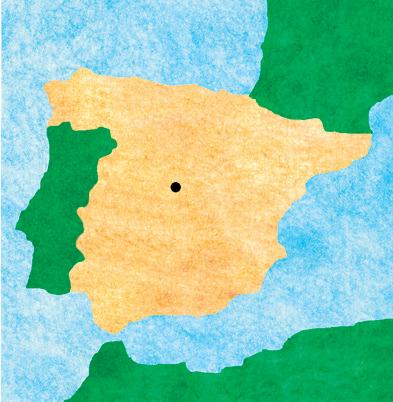
Southern Portugal
Southern Portugal is a superb and rich wildlife destination. The Algarve province and its northern neighbour the Alentejo has a highly diverse landscape from the cliffs, dunes and tidal marshes on the coast to the extensive oak pastures, steppes and rocky hills in the interior. Whether you enjoy birdwatching, searching for orchids or simply a pleasant ramble through a flower-dotted landscape, southern Portugal is a great destination at any season.
• The guide that covers the wildflowers, birds and all other wildlife
• Routes, where-to-watch-birds information and other observation tips
• Insightful information on landscape and ecology
“Everything you need to turn up in the right place and at the right time to find some of the best wildlife in Europe”
Chris Packham – BBC Springwatch www . cr OSSBILL guI de
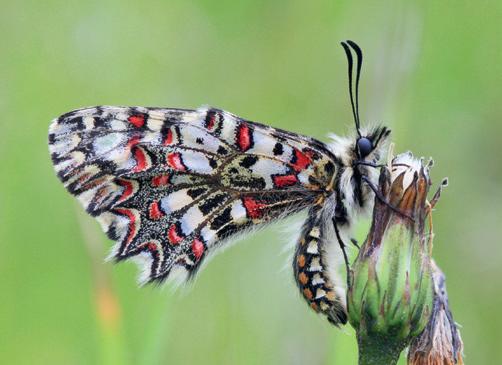
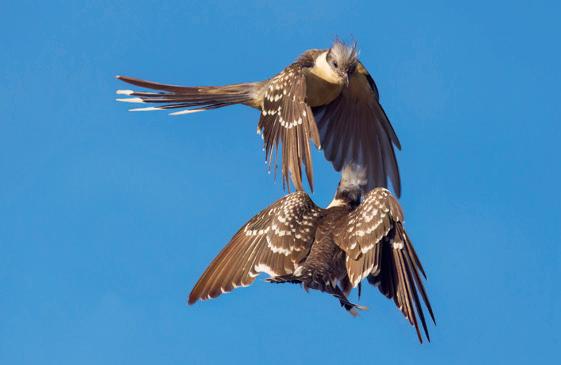
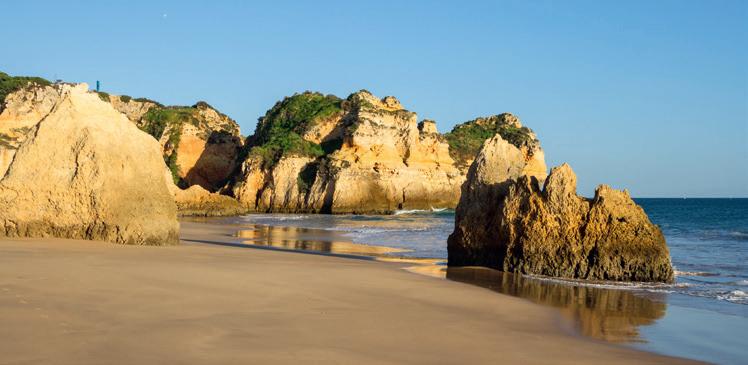
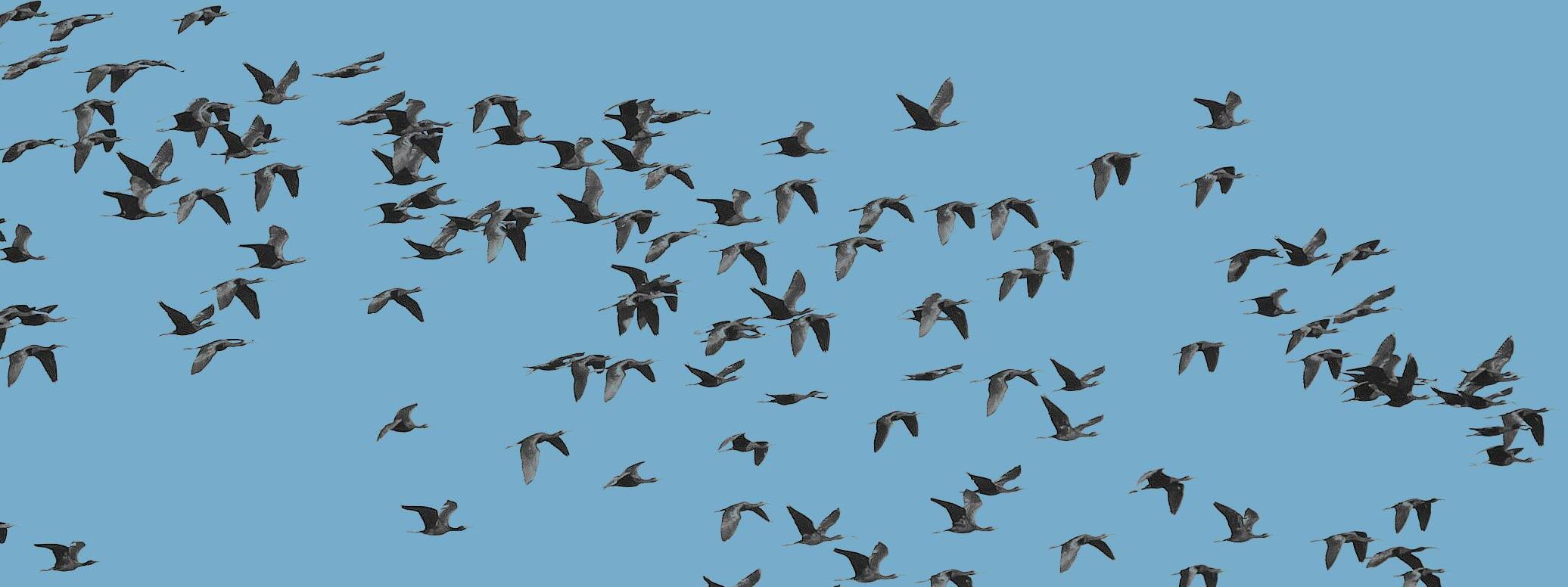 LISBON
LISBON
rg - I f y O u wa N t t O S ee m O re
S . O





































































 LISBON
LISBON